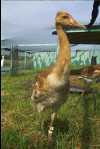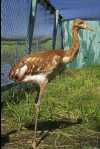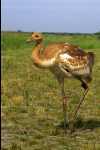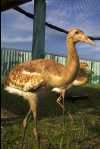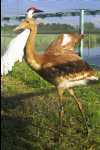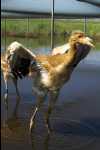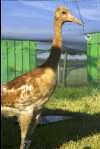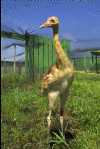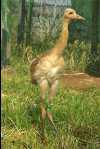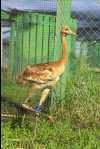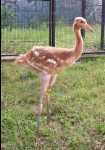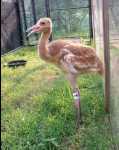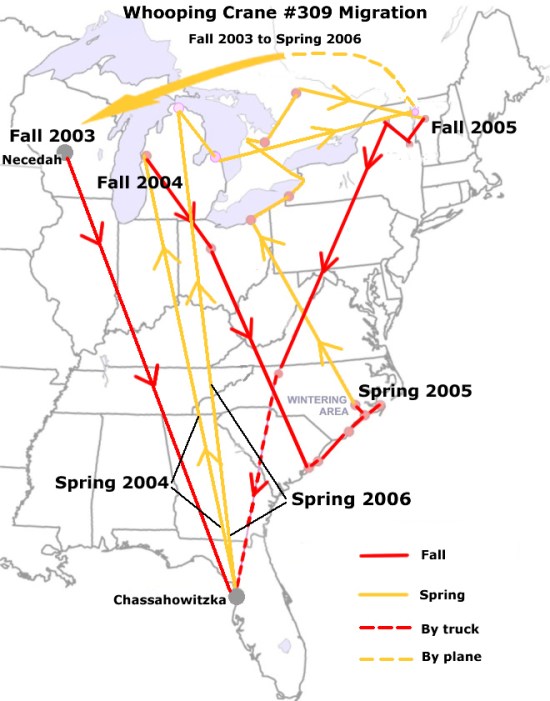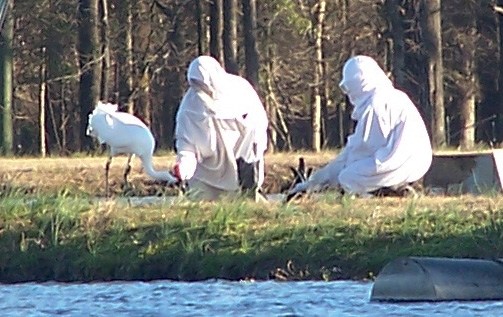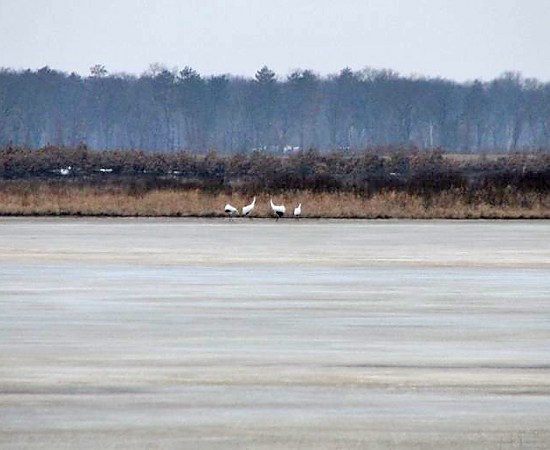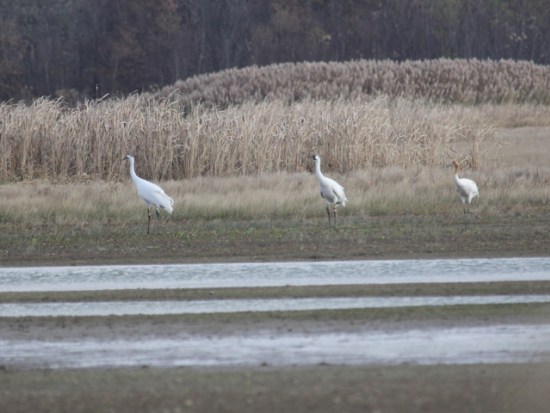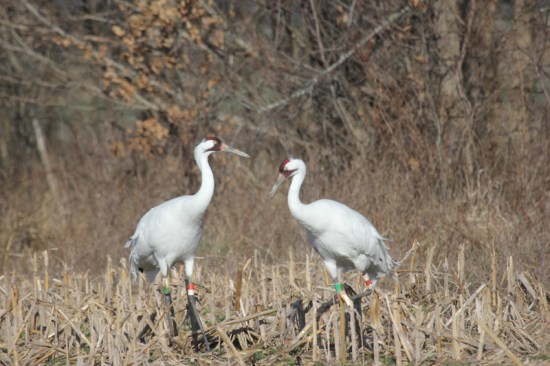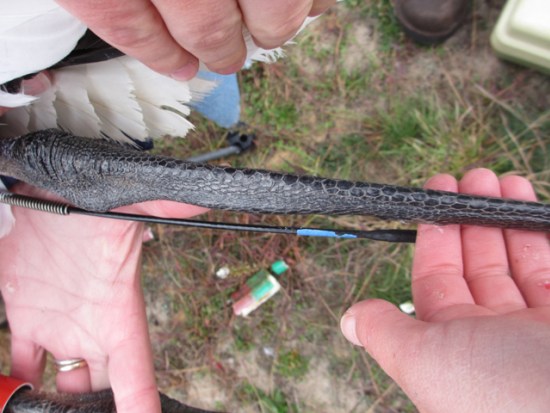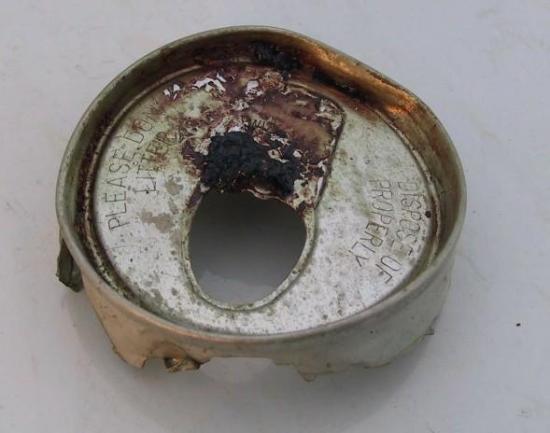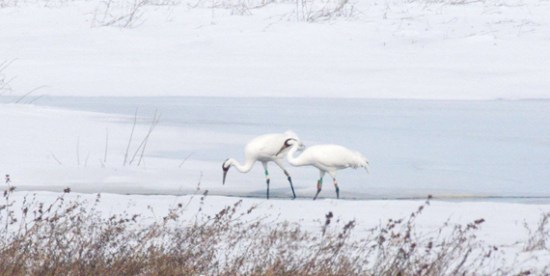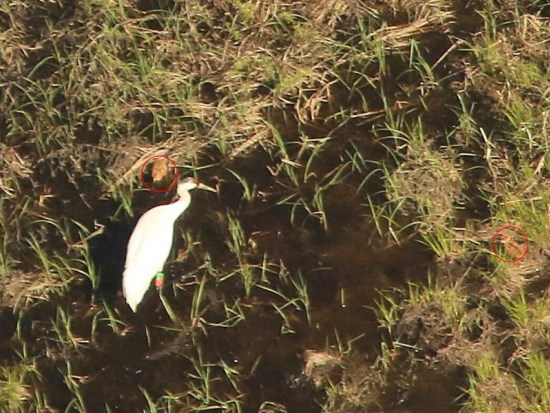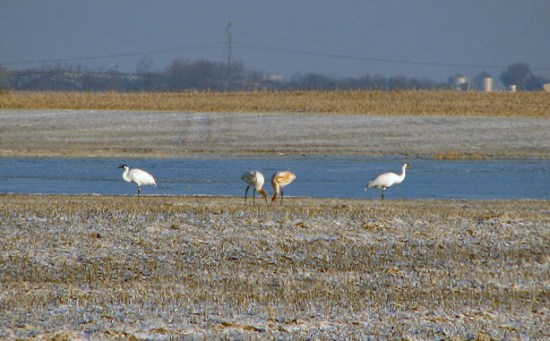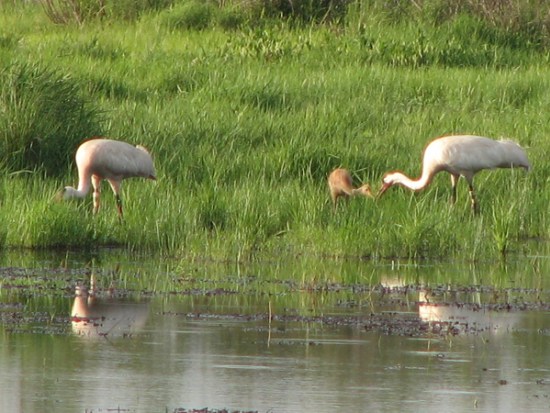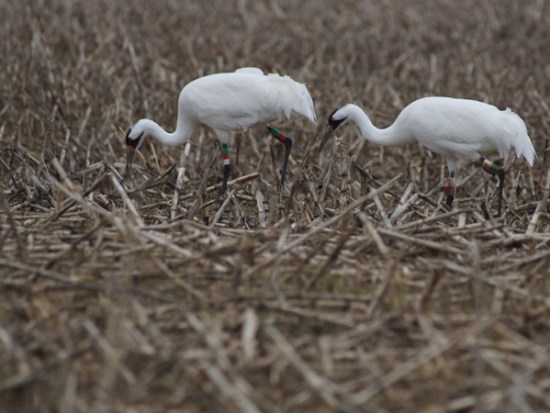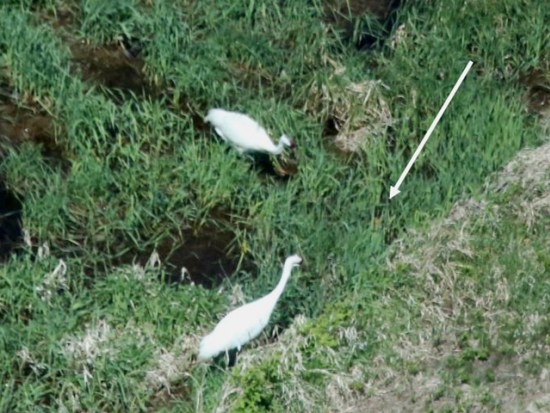The third year of the reintroduction! The aircraft-guided method was used to teach these young Whooping Cranes a migration route from the Necedah National Wildlife Refuge in Central Wisconsin to Florida’s Gulf Coast at the Chassahowitzka National Wildlife Refuge.
The southward migration began on October 16, 2003, and ended 54 days and 1,191 miles later on December 8, 2003.
Crane #1-03
Sex: Female
Hatch Date: April 21, 2003
Migration Training: The oldest crane but one of the smallest. Very attentive and the best follower. Usually ran along near the right side of the trike during taxi-training. Might be the lowest-ranking female, but that may change when the whole flock gets combined and works out their pecking order.
History
First Migration South: Flew all but 33.1 miles with the ultralight.
Spring 2004: She was the first of all her flock mates to attain her adult voice (Jan, 2004) during the winter. Began first migration north at 9:33 a.m. March 30, 2004 in a group of eight 2003 flock mates (#1-03, #3-03, #5-03, #9-03, #12-03, #16-03, #18-03, #19-03). They flew on Mar. 31 and April 1. They stayed in Macon County, NC. until afternoon of April 3, when trouble arrived. The cranes were discovered and harassed by 5 humans who came right up to them. They flushed, and one crane hit a power line. Fortunately the bird was able to keep flying. The group circled for 1.5 hours before heading north, flying after darkness fell. Their location was unknown for the next two nights. The group of 8 was found in a farm field in southwestern Ohio after dark on April 5, thanks to the help of PTT readings and an airplane search. They flew on to west central Ohio on April 6. They stayed there again April 7, after taking off but returning again after #3-03 did not join them in flight, and again on April 8. On April 9 the group flew westward and separated south of Celina, Ohio. The group of five (#1-03, #5-03, #9-03, #18-03, and #19-03) roosted in a marsh in southwest Michigan. The five departed April 10 under clear skies. After some lingering when they came to Lake Michigan, they turned south, following the shoreline of the lake for more than an hour before settling to roost in a large marsh in the southwest area of the state. April 11 they left, flew across the border to Indiana and then into Ohio and returned the same day to West-central Michigan, where they remained all summer on an unfamiliar side of Lake Michigan.
Fall 2004: Cranes #1-03, #5-03, #9-03 and #18-03 began migration from Mason County, Michigan and moved south into Ohio on November 7. They appeared to be retracing their spring path until they detoured to South Carolina where #5-03 was killed, likely by a predator, on Nov. 13/14. Perhaps spooked by seeing the death of their flock mate, #1-03 (with #9-03 and #18-03) moved northward the next day to Tom Yawkey Wildlife Center in Georgetown County, South Carolina. After several short northward flights, the three began moving south. Were found inland in Jones County, NC on Nov. 20. They wintered in NC.
Spring 2005: Departed Jones County, NC on migration March 30 with #9-03 and #18-03. Seen April 6 with #9-03 and #18-03 in western New York state, just across the Penn. border. They apparently followed the Lake Michigan lakeshore NE. The group had been reported in flight along the south shore of Lake Erie near Ripley, New York, on 6 April. This would mean they would have to somehow get around two of the Great Lakes to make it home. On April 15 the three were confirmed in Ontario, east of Lake Huron. They will most likely be returned to Wisconsin in an attempt to reorient them. With two of the Great Lakes separating them from the core introduction area, there is little likelihood they would make it back on their own. For now, they need to be in proximity to the rest of the population. The more opportunity they have to mingle, the greater the chance of proper mate selection and eventually breeding. A PTT reading indicated that #1-03 roosted in Algonquin Provincial Park near the Quebec border on the night of 16 April and then left the following morning. Low-quality readings for #1-03 on April 17-20 showed movement southbound to near the northern shore of Lake Ontario. The next reported sighting of #1-03 and #18-03 was on April 22 in a harvested cornfield on the southern shore of Georgian Bay. The two were still there on 25 April but the third crane, #9-03, has not been reported with them since 14 April. On April 27, #1-03 and #18-03 left Owen Sound and were seen near Tobermory (northern tip of the Bruce Peninsula, Ontario). Next confirmed in Chippewa Cty. on April 29. Then poor quality PTT readings in mid May indicate they had flown southward into the north-central Lower Peninsula of Michigan. Sure enough, #1-03 and #18-03 were finally confirmed by a citizen sighting 22 May in central Missaukee Co, MI. On the evening of June 30, #1-03 and #18-03 were successfully captured in Michigan by WCEP trackers. They were transported by aircraft to the Necedah National Wildlife Refuge and released. Both birds appear to be well. Hooray!
Fall 2005: Began migration Nov. 17 with #11-03. They later joined in flight with #2-01 & #12-02, #3-02 & #17-03. The group roosted that night in Will County, IL. They flew Nov. 18 to SW of Indianapolis, Indiana. They were all still at this Marion County, IN stopover site in mid-December. On Dec. 20, a pair of whoopers that might have been #1-03/#11-03 were sighted on Colleton County, SC. The pair arrived at the Chassahowitzka pen site on Dec. 22. They stayed in the pen area and made several short flights in the next few days.
Spring 2006: Still in SC on March 23 but this bird (with #11-03??) may be one of the two reported back in Michigan April 2. This was the same general area occupied by#1-03 and #18-03 in 2004 and 2005 before the latter two birds were retrieved and re-released in Central Wisconsin early last summer (2005).
Fall 2006: She was captured in Wisconsin on Nov. 8 by the crane team to replace her radio transmitter before she left on migration. Her nervous mate (#11-03) watched, but all went smoothly. She and mate #11-03 began migration Nov. 19 and made it to Kankakee County in NE Illinois that night. They successfully migrated to their winter territory in Colleton County, South Carolina, where they were reported in December.
Spring 2007: Left SC on migration (with #11-03) on March 24. She and mate and #11-03 arrived on their territory on Necedah NWR on March 29. On September 28 the intact carcass of #1-03 was discovered. Tracking data indicated that she probably died on the night of September 25. Experts later thought she had been killed by an eagle. Her mate left the pair’s summer territory the next day.
Click here to jump to the top of this page.
Crane #2-03
Sex: Male
Hatch Date: April 22, 2003
Migration Training: This large bird will likely be the biggest of the entire flock. He uses his size and is aggressive to the costume. He lost his “bustle” of feathers during shipping from Patuxent, but they will grow back. A good flyer and follower in training.
History
First Migration South: Turned back and landed at Necedah on day 1 of the migration along with #10-03, #11-03 and #13-03. He was reluctant to follow while #3-03 was away recovering from surgery, and appeared withdrawn socially. He turned back twice on Day 24 of the migration and was crated for transport. Missed 134.1 miles.
Spring 2004: Left Chassahowitzka together with the other 7 remaining chicks on April 7 at 9:10 a.m. They flew until rain stopped them, landing in Jefferson Cty., FL at 3:35 where they roosted that night. Took off April 8 in the group of 8 but a thunderstorm separated the cranes into 3 groups. Cranes #2-03, #7-03 and #11-03 — each now traveling solo — were located by radio signals April 9 in Georgia after after gaining about another 100 miles. On April 10, #2-03 left. Signal next detected April 16, in flight south of Bloomington, Illinois. No signal detected for another 33 days, until May 19, 2004 — 28 miles from Necedah! May 20 he circled over Necedah NWR for an hour before landing for an hour. He flew off to a nearby county and joined #10-03 and #13-03 to roost in a cornfield.
Fall 2004: Left Wisconsin October 23 with #17-03. Separated from #17-03 Oct. 24. Arrived a few days later in Iroquois County, IL. Stayed there till Dec. 12. (He was alone, and the landowner was convinced that this crane likes the Canada goose decoys that are sharing his wetland!) Next located with #10-03 and #13-03 during an aerial survey by Lara Fondow on January 18 in a managed wetland in Colleton County, South Carolina.
Spring 2005: Began migration March 20 together with #10-03 and #13-03. On April 3, #2-03 was seen flying west of Chicago. On April 4 he arrived at Necedah NWR. He and #13-03 were together all summer.
Fall 2005: Began migration with #9-02 on Nov. 17. He and #9-02 apparently arrived on Dec. 5 at the same site occupied by #13-02 and #18-02 in Franklin County, Tennessee, where they still were present at the end of December.
Spring 2006: Began migration with #9-02 on Nov. 17. They arrived in Wisconsin March 18. They were observed building a nest on 27 March, but they stopped using that site. On April 13, they began incubating eggs in a new nest on their territory in Monroe County, WI. They did better than of any of the 5 nesting pairs. They guarded their eggs and stayed on the nest. But their clutch was lost after 15 days, before the eggs could hatch. The pair remained in the local area after loss of their nest. Then they moved to another place in Monroe County, where #2-03 was suspected to be molting.
Death of #2-03 in July, 2006: The carcass of #2-03 was discovered on July 16 in an area with dense trees but no standing water. He was likely the victim of a predator. Male #2-03 was the first member of a breeding pair to die since the reintroduction began in 2001. His mate was #9-02.
Click here to jump to the top of this page.
Crane #3-03
Sex: Female
Hatch Date: April 22, 2003
Personality Characteristics: Aggressive as a young chick but turned passive in June. Later she got a tenacious attitude back again. The first of the seventeen birds to officially get airborne. Her first short, low flight was on July 1st. She often led the training flights and was a high ranking bird in the social hierarchy of her group. Best buddies with #2-03. After the pre-migratory health check, she developed a limp that worsened. In early October, the team discovered she had a fractured knee. The break probably occurred during the health check handling, and she had surgery to correct it on October 7. She was reunited Oct. 17 with her flockmates and no aggression took place.
History
Spring 2004: Began first migration north at 9:33 a.m. March 30, 2004 in a group of eight 2003 flock mates (#1-03, #3-03, #5-03, #9-03, #12-03, #16-03, #18-03, #19-03). On April 9 the group separated south of Celina, Ohio. Birds #3-03, #12-03 & #16-03 retreated eastward, toward the location they had just left. On April 11 Cranes #3-03, #12-03 & #16-03 were observed feeding in a cornfield in west-central Ohio. They remained until April 24, when the three headed north. On April 25th they continued northwest and encountered Lake Michigan on an unfamiliar side at exactly the same point that the group of five had two weeks earlier. Cranes #3-03, #12-03 & #16-03 remained together in Michigan until they finally figured out how to get around the huge obstacle of Lake Michigan. They arrived in central Wisconsin on July 26 and were discovered near Necedah National Wildlife Refuge on July 28, completing their interrupted migration!
Fall 2004: Cranes #3-03, #12-03 and #16-03 left Necedah Nov. 20 and flew to Jefferson Cty., WI. On Nov 22 they were in Cook County, IL. Stayed in LaPorte County, Indiana from Nov. 22 until resuming migration on Dec. 18-20. They roosted in or near Fairfield County, South Carolina, on Dec. 22nd, then moved to Marion County, FL. for several days. They arrived at the Chassahowitzka pen site at midday on Jan. 2nd, roosting that night near the constructed oyster bar in the pen. They were the first HY2003 whooping cranes to return to the Chassahowitzka pen site after fall migration. Spent much of the winter on a horse farm in central FL. Spring 2005: #3-03, #12-03 and #16-03 departed on migration from Marion County, FL on March 20. Will they go back to MI or WI? PTT readings for #12-03 showed the group roosted in southern Indiana–on the correct migration route–on March 20! The three were reported back in Necedah area March 30. In April she apparently joined #7-03 and began hanging out with him. (Her radio transmitter is nonfunctional and she cannot be tracked.)
Fall 2005: Began migration Nov. 17 with #16-02. They were tracked into northern IL, but their roost site was not determined. No further locations determined until they arrived at their old Florida pen site at Chassahowitzka NWR on December 14 at 2:25 PM! They moved later to a ranch in Pasco County, FL.
Spring 2006: #3-03 left Florida around March 6 with #16-02. They spent summer in Wisconsin.
Fall 2006: She began migration Nov. 19 , with #17-03, made it to NE Illinois that night. They successfully migrated to Florida, where they were in Hernando County until Dec. 19 when they left that location. They visited the Chass pen but haven’t been seen since they left there on Jan. 28.
Spring 2007: Began migration March 5 (with mate #17-03 and pair #12-03 and #16-03). Confirmed back on Necedah NWR (with mate #17-03) during an aerial survey on 23 March. Their arrival date was later set at March 15, according to the refuge’s automatic data-logger. They deserted their first nest, but nested again and began incubating around May 14. Because #3-03 and #17-03 came from the same parents, they are full siblings — brother and sister. To help ensure genetic diversity among the reintroduced wild flock, experts went to the nest about 3 weeks later to swap the siblings’ egg with another egg. The male (#17-03) was sitting on the nest. Both cranes flushed from the area, and ICF staff quickly made the egg switch. They discovered that the pair’s egg was not a good one. After several hours had passed and the adults hadn’t returned to the nest, they swapped the good ICF egg with a plaster fake egg. The egg from ICF is due to hatch very soon. It was brought back to ICF for incubation, where the chick will become part of the DAR (Direct Autumn Release) project.
Fall 2007: Crane Pair #3-03 and #17-03 joined up with #16-02 around Necedah NWR on Nov. 20 and they left together on migration on November 22. The pair (#3-03 and #17-03) were still in Marion County, Indiana, at the end of December.
Spring 2008: Female #3-03 and male #17-03 left their territory in Marion County, Florida, on February 5 or 6 and moved to an undetermined location. They were back on their territory at Necedah NWR on March 30. Everyone was thrilled to see the pair incubating on a nest beginning on April 9 or 10. A nest check on May 19 found 1 broken fertile egg and 1 intact fertile egg. The good egg was brought to ICF for incubation.
Fall 2008: Female #3-03 and mate #17-03 were found in Jackson County, Indiana, on January 1, 2009. They were reported leaving that area on January 3. No further reports and she has a nonworking transmitter so cannot be tracked.
Spring 2009: Reported back at Necedah NWR in Wisconsin by March 19. She and her mate #17-03 were found on a nest April 8! The nest failed but one rescued egg hatched May 8 into chick #9-09, which would have become a captive breeding bird but it did not survive. By May 21 the pair was re-nesting but abandoned that nest June 7. A rescued egg was incubated in Maryland for the ultralight flock but the chick did not survive. The pair stayed together in the area all summer.
Fall 2009: Female #3-03 was captured for transmitter replacement on October 20 and released.She and her mate #17-03 began migration on November 15, a day with clear skies and north winds to help push them south. Ten whoopers began migration the same day. Pair #3-03 and #17-03 next appeared when they continued migration on November 30 and landed to roost in Knox County, Indiana, with #16-02 and #16-07, #12-05 and #22-07, and (DAR) 38-09.
Spring 2010: The signal of #3-03 was detected on March 17 at Necedah NWR in Wisconsin. Even though they had not observed yet, she and her mate (#17-03, whose transmitter does not work) were among the earliest arrivals for the new nesting season. They left their winter territory in Indiana on March 9 or 10. They were reported back at Necedah NWR in Wisconsin with an active nest on April 1 or 2! The nest failed and a re-nest on May 3 also failed. Two of their eggs were rescued and hatched at ICF; the chicks were transferred to Patuxent WRC in Maryland. The pair later re-nested for a third time—the lucky one! This late-season nest produced two chicks (W4-10 and W5-10). By the end of June one chick had disappeared but W4-10 survived until July 14 and the cause of death is being investigated. Cranes #3-03 and #17-03 make an unusual pair because they are full siblings.
TWO CHICKS hatched in June, 2010! They were the first chicks for pair #3-03 and #17-03.
On June 17 the parents and chick W4-10 moved to a new spot. Sadly, on July 14 the intact remains of their chick W4-10 were found there. The carcass was sent to the National Wildlife Health Center in Madison, Wisconsin, to determine cause of death.
Fall 2010: Female #3-03 and her mate #17-03 began migration from Necedah NWR on November 17. They wintered in Knox County, Indiana, just as they have previously. The pair was there on Feb. 12 but not when the area was checked on Feb. 17.
Spring 2011: Female #3-03 and her mate #17-03 were reported back in the Wisconsin core area by March 21. They were incubating on a nest by April 9 and hatched a chick (W2-11) on May 9! Their chick disappeared when a tornado passed through the area on May 22. They did not attempt another nest this spring.
On August 16, #3-03 was observed injured near a refuge road bordering her territory. She was brought to ICF for examination. She was emaciated with an infected left hock and was euthanized. Her carcass has been sent to the National Wildlife Health Center in Madison for necropsy. She had last been observed with her mate (#17-03) on July 6.
Click here to jump to the top of this page.
Crane #4-03
Sex: Male
Hatch Date: April 24, 2003
Personality Characteristics: Average bird with no bad habits. Sara says it is the MOST IMPROVED bird and seems to have recovered from initial shyness. This is the bird that often stands outside the pen while the others chase after the aircraft. Then it seems to realize it can’t get back inside the pen so it flies after them and joins the training.
First Migration South: Flew every mile!
History: Attained adult voice end of March 2004.
Spring 2004: Left Chassahowitzka together with the other 7 remaining chicks on April 7 at 9:10 a.m. They flew until rain stopped them, landing in Jefferson Cty., FL at 3:35 where they roosted that night. Took off April 8 in the group of 8 but a thunderstorm separated the cranes. #4-03, #6-03 and #17-03 stayed together, but flying southward. They landed in a north Florida wetland at 4:40 p.m. Cranes #4-03, #6-03 & #17-03 were detected in flight in northwestern Georgia or northeastern Alabama in late afternoon April 10 and in central IL on April 16. On April 17, #4-03, #6-03 and #17-03 were airborne at 9:40 a.m. Flying for almost 11 hours and well after darkness fell, they landed in southeast Minnesota, approximately 65 miles southwest of the Necedah NWR reintroduction site. They stayed in that MN location until April 23 and wandered until staying in LaCrosse County, WI. Crane #4-03 arrived at Necedah May 15, officially completing his migration.
Fall 2004: Left Necedah NWR on Nov. 5 with #11-03 and flew to Kankakee Cty., IL. Still together, #4-03 and #11-03 arrived late Nov. 10 in Washington County, Georgia. On Nov. 18, they were found in Glynn County, Georgia. Verified near McIntosh, Liberty County, GA on November 24th. Next located on Dec. 18 during an aerial-radio search in an area about 14 miles south of crane #17-03 in Colleton County, SC. Remained there in a Wildlife Management area with #11-03.
Spring 2005: Not at the roost site on March 30. May have begun migration with #11-03. Cranes #11-03 and #4-03 joined with chick #12-04 over Indiana on April 6th! They were tracked into WI, where they were in Sauk County on April 7–migration complete. He was on the refuge all summer, was seen quite frequently and acted totally normal till he was found dead on October 27, 2005, with no outward trauma signs. A necropsy is being performed at the National Wildlife Health Center at the University of Wisconsin (Madison) to determine the cause of death.
Click here to jump to the top of this page.
Crane #5-03
Sex: Male
Hatch Date: April 29, 2003
Personality Characteristics: Probably the best flyer in the group but stand-offish to handlers. Very watchful and alert. In the beginning, stood away from the plane, but still paid very close attention to the trainers and plane.
First Migration South: Flew every mile!
History
Spring 2004: Began first migration north at 9:33 a.m. March 30, 2004 in a group of eight 2003 flock mates (#1-03, #3-03, #5-03, #9-03, #12-03, #16-03, #18-03, #19-03). On April 9 the group separated south of Celina, Ohio. The group of five (#1-03, #5-03, #9-03, #18-03, and #19-03) was stymied by being on an unfamiliar side of Lake Michigan. (Again see Crane #1-03 for updates on this group, which stayed in Michigan.)
Fall 2004: Began migration from Mason County, Michigan on Nov. 7 with #1-03, #9-03 and#18-03. Killed by a predator, probably a bobcat, while roosting with #1-03, #9-03, and #18-03 on a mudflat on the Cape Romain NWR in Charleston County, SC on the nights of Nov. 12/13, 2004.
Click here to jump to the top of this page.
Crane #6-03
Sex: Male
Hatch Date: May 1, 2003
Personality Characteristics: Good follower. Richard says he’s unremarkable: always where he’s supposed to be–and that’s what makes him remarkable. Dan says #6-03 doesn’t like him. “He’s a tough bird who stands his ground but he’s not aggressive.”
First Migration South: Flew every mile!
History
Attained his adult voice in March, 2004.
Spring 2004: Left Chassahowitzka together with the other seven remaining chicks on April 7 at 9:10 a.m. They flew until rain stopped them, landing in Jefferson Cty., FL at 3:35 and roosted there. Took off April 8 in the group of eight but a thunderstorm separated them. Cranes #4-03, #6-03 and #17-03 stayed together, but flying southward. They landed in a north Florida wetland at 4:40 p.m. Cranes #4-03, #6-03 & #17-03 were detected in flight in northwestern Georgia or northeastern Alabama on April 10 and in Illinois on April 16. On April 17, #4-03, #6-03 and #17-03 flew for almost 11 hours; well after darkness fell, they landed in southeast Minnesota, approximately 65 miles southwest of the Necedah NWR reintroduction site. The three stayed in that MN location until April 23 and were seen flying along the Mississippi River in late April. Next were reported back at Necedah May 12. (On May 13, #18-02 led #6-03 and buddy #17-03 in flight to an area at Mill Bluff State Park where the 2002 cranes hang out–taking the youngsters under her wing.)
Fall 2004: Left Necedah November 7 and flew to Iroquois County, IL, the same county that #2-03 has been occupying since Oct. 26th. Reported at Hiwassee State Wildlife Refuge in Meigs County, TN by Nov. 10 or sooner. Departed from Hiwassee to resume migration on Dec. 12. Wintered at Lake Woodruff NWR, Florida.
Spring 2005: Began migration March 29 from Volusia County, FL. Roosted in Adams County, Wisconsin on April 3 with crane #1-02. By April 6 the two had moved to Juneau County, WI. They were seen in and around Necedah NWR throughout the summer. They sometimes associated with #4-03.
Fall 2005: Began migration with #1-02 on November 17. They arrived at Jasper-Pulaski SWA, northwestern Indiana, in late afternoon. He and #1-02 were at Hiwassee (TN) when the 2005 ultralight chicks were there at the end of November. #6-03 was still at Hiwassee as of Dec. 14. They arrived at Lake Woodruff NWR, Florida, on December 20–where they spent the winter of 2004-05.
Spring 2006: Began migration from Florida to Wisconsin (with #1-02) on March 27 or 28. No reports received during migration. He and #1-02 were found back on their territory in Wood County, WI on April 6.
Fall 2006: Began migration from Wisconsin’s Necedah NWR on November 9 (along with #1-02). They roosted that night in northern Illinois. They were in Daviess County, Indiana on Nov. 24. In December they safely made it to their winter territory on a wildlife refuge in Volusia County, FL.
Spring 2007: Began migration from Volusia County, FL on Mar.7. Confirmed back in Wisconsin’s Juneau County (with mate #1-02) during an aerial survey on March 23. On May 17 they were reported building their first nest. On July 12, the decomposed carcass was found on his territory in Juneau County, Wisconsin.He was on a dry marsh and flightless due to molt (loss and regrowth of feathers). He was killed by a predator, apparently a large mammal. Tracking data indicated that he died on or about July 6. This area of Central Wisconsin was drought-stricken. No water was present in the immediate area where the death occurred. The only standing water on the territory was near the dikes, and very little cover was available to a molting bird.
Click here to jump to the top of this page.
Crane #7-03
Sex: Male
Hatch Date: May 4, 2003
Personality Characteristics: Wimpy and small and often cries to the puppet. “Follows and begs right next to you, nonstop.” Clingy. This bird loves to investigate and peck at the aircraft and will not leave it alone. Often appears as if he plans on jumping in the pilot’s seat. VERY curious! 6/23: Handlers watched him find a garter snake, then shake it until it was dead. Crane #11-03 then swiped the snake and swallowed it whole! Wasn’t yet a strong flyer at beginning of August. Reminds Brian of Crane #9 from the 2002 flock. Last of the 2003 chicks to attain adult voice.
First Migration South: Flew all but 33.1 miles
History
Spring 2004: Left Chassahowitzka together with the other 7 remaining chicks on April 7 at 9:10 a.m. They flew until rain stopped them, landing in Jefferson Cty., FL at 3:35 where they roosted that night. Took off April 8 in the group of 8 but a thunderstorm separated the cranes into 3 groups. Cranes #7-03, #2-03 and #11-03 –each now traveling solo–were located by radio signals April 9 in Georgia after each gained about another 100 miles. On April 10, #7-03 left the roost in Henry County, Georgia, at 9:29a.m. and was not tracked for several days. On April 16, several visual sightings of #7-03 in flight were made. On June 2 he arrived at Necedah NWR, HOME to roost!
Fall 2004: He departed Necedah NWR on migration, and guided the now-feathered youngster #18-04 along with him! The two landed to roost in west-central Indiana the first day out. Unfortunately, #7-03 took off again and flew about 60 miles farther, leaving untrained #18-04 behind. On Nov. 10, #7-03 roosted just shy of the southeast coast of Georgia in McIntosh County. He was found in Chatham County, Georgia, on Nov. 14-15th. By Nov. 17th, he had moved to Beaufort County, South Carolina. He remained in marsh and a harvested cornfields in southeast South Carolina, just north of the Georgia State line, through at least Feb. 7, 2005.
Spring 2005: On April 4 he spent time in Monroe County, WI and completed migration to Necedah NWR that evening. Later in the week he moved to an area south of Necedah NWR where he spent time in 2004, but returned to Necedah NWR in April. He apparently joined #3-03 (nonfunctional transmitter) on 17 April and both birds were later found near Paul J. Olson SWA, Portage and Wood Counties, where they stayed for several days. He was last seen August 4 on Necedah NWR with #2-04, #3-04, #12-04, #16-04 and #17-04. (He cannot be tracked because his transmitter no longer works.) He was seen often in summer and fall on Necedah NWR.
Fall 2005: Began migration November 17. Arrived at Jasper-Pulaski SWA, northwestern Indiana, in late afternoon. He was next reported on Nov. 29, alone in Jackson County, Alabama. He was still there in mid December. He did not reappear on his previous wintering site in Beaufort County, South Carolina.
Spring 2006: Has not been detected since Dec. 2 in Alabama. Arrived safely in WI.
Fall 2006: Began migration from Wisconsin’s Necedah NWR on November 9 along with #10-05, #11-05, #12-05 and #19-05. They made it to northern Illinois that night. No further reports until January 2, when they were found in Levy County, FL!
Spring 2007: Departed Alachua County, FL on March 8. Back on the Necedah National Wildlife Refuge in Wisconsin by March 12! Seen on March 26 unison calling and doing territorial behavior with #2-01. By April 5 he and W1-06 remained together and were no longer hanging out with several other whooping cranes there.
Fall 2007: Began migration from Wisconsin on November 21 along with #2-04, #12-04, #11-05, #14-05, and W1-06 (the flock’s only wild-hatched chick so far). Last recorded with #2-04, #12-04, #11-05, #14-05 and W1-06 at a migration stop in northeastern Georgia on November 30. He had separated from all of these cranes by Dec. 10 and wasn’t recorded again until March in Minnesota (see below).
Spring 2008: Male #7-03 (with #12-05) was confirmed back in Wisconsin at Necedah NWR on March 23. Before that, he and #12-05 were reported together in Houston County, Minnesota, on March 14 and 15! Both birds may have wintered together at an undetermined location in Florida. In early April, Sara Zimorski said, “We were excited to see #7-03 and female W1-06 hanging out together and hope they may become a pair.” It did happen, but it didn’t last, and #7-03 actually displaced #1-01 from his long-held territory on the refuge.
Fall 2008: Left Wisconsin on Nov. 17 in a large group of whooping cranes and migrated successfully to Alachua County, Florida by Dec. 31. His unofficial mate, female #21-07, migrated with him, but she was found dead in Putnam County, Florida on January 3, 2009. When #7-03 was no longer in the same location as #21-07, trackers began to suspect something was wrong. Eva Szyszkoski said that data from outside observers indicates that #7-03 may have stuck around for a few days after #21-07’s death, and then moved west to Alachua County, Florida, where he was with #11-05, #12-05, #14-05, #16-07, #24-07, #8-04, #19-09, #10-08 (formerly 810) and DAR 37-08.
Spring 2009: Cranes #7-03, #8-04, and #14-05 began migration from Alachua County, Florida, on March 5 or 6. Reported in Greene County, Indiana during March 9-15. He was reported back at Necedah NWR in Wisconsin by March 19. Sara Zimorski reports, “Apparently #7-03 has been trying (and may have succeeded) to steal W1-06 away from #10-03. Last year #7-03 and W1-06 were hanging out together before #10-03 came along so we’ll see what happens.” It didn’t last, but male #7-03 paired up with female #26-07 and remained in the core area all summer. The new pair staked out the pen site of one of the ultralight chick cohorts as their territory. They were very aggressive about it, especially at evening roost-check time.
Fall 2009: By December 7, all but 11 Whooping Cranes were gone from the new Eastern flock’s summer home in Wisconsin. Those 11 included pair #7-03 and #26-07, two single males (#6-05 and #13-07) and seven of this year’s nine DAR chicks. They surprised experts when they chose to begin migration on a very snowy December 11, after being content to roost on ice and standing in the brisk winter wind for the previous week. That day they reached Winnebago County, Illinois! The birds had moved on by the time trackers got there the next day. Eva said, “When we finally got a reading, we were all surprised to see that they had flown east of Indianapolis, Indiana, 240 miles southeast of their last location and right on track with the main migration route for Sandhill Cranes. I arrived at the location and heard all 11 signals coming from the same area. But I could not see them since it was dark outside.” The next morning they made a couple of local movements before traveling only 50 miles to the Muscatatuck National Wildlife Refuge, near the Indiana/Kentucky Border. In the first three days of migration, which was the first-ever migration for the seven chicks, they flew a total of 430 miles! Pair #7-03 and #26-07 safely reached their winter home in Alachua County, Florida.
Spring 2010: Present (with #26-07) at Alachua County, Fl area on February 28 but no longer there by March 4. They were reported back on Necedah NWR by March 22.
Fall 2010: Pair #7-03 and #26-07 apparently began migration from Necedah NWR on November 23. They were next found during an aerial survey on December 13 on their previous wintering territory in Alachua County, Florida.
Spring 2011: Pair #7-03 and #26-07 were on their winter territory when checked on March 1, but they apparently began migration on/by March 8. They had arrived at their territory on Necedah NWR by March 25. These first-time nesters were incubating on April 10 but their first nest failed on May 4.
Sad news came in July: The carcass of male #7-03 was discovered and collected from his summering territory on Necedah NWR on July 21.
Click here to jump to the top of this page.
Crane #9-03
Sex: Female
Hatch Date: May 5, 2003
Personality Characteristics: Most independent of this cohort. Strays farthest from trike during taxiing sessions. Small female but soon was dedicated to the aircraft and followed everywhere. Brian called her a super forager: “You could drop that bird in the middle of a city and she’d find something to eat!”
First Migration South: Flew all but about 18 miles with the ultralight planes. Little did they know that, at least until 2008, she would become a wandering female. Read her history to see what we mean!
History
Spring 2004: Began first migration north at 9:33 a.m. March 30, 2004 in a group of eight 2003 flock mates (#1-03, #3-03, #5-03, #9-03, #12-03, #16-03, #18-03, #19-03). They were flushed from their roost by curious people intruding too close. The cranes took off into the darkness. That, plus a strong west wind, pushed them to the east side of Lake Michigan. On April 9 the group separated south of Celina, Ohio. The group of five (#9-03, #1-03, #5-03, #18-03, and #19-03) was stymied by being on an unfamiliar side of Lake Michigan and they spent summer in Michigan.
Fall 2004: Began fall migration from Mason County, Michigan, on Nov. 7. with #5-03, #9-03 and #1-03. Perhaps spooked by seeing the death of their flock mate #5-03 on Nov. 13/14, crane #9-03 (with #1-03 and #18-03) moved northward the next day to Georgetown County, South Carolina.After several short northward flights, the three began moving south. They were found in Jones County, North Carolina on Nov. 20, where they spent the winter.
Spring 2005: Began migration from Jones County, NC March 30 with #1-03 and #18-03. But these 3 cranes again got lost. The three were confirmed in Ontario, Canada — east of Lake Huron. On May 8, #9-03 was alone on the northern shore of the St. Lawrence River, northeast of Lake Ontario, just across the U.S. (New York) border. She was seen leaving the area on that morning after a one-night stop. She was next spotted in west central Vermont on June 9. The WCEP tracking team hoped to catch her if she stayed there, but she flew away on June 30th. The flooded fields where she’d been staying were drying up, so it’s not surprising that she left. She was next reported on August 11-13, 2005 at a wet hayfield in Lewis County, New York. (Her wayward flock mates #1-03 and #18-03 were successfully captured June 30 in Michigan by WCEP trackers and flown by aircraft to the Wisconsin Wildlife Refuge and released.)
“She’s an important bird to the program, and if we leave her where she is we eliminate any chance there is that this bird will mate,” said OM pilot Joe Duff. “She’s a good, wild bird, certainly independent. The only problem is she happens to be a little lost.”
Fall 2005: She was reported again on October 27, 2005 near her last sighting in northeastern New York. And then—HOORAY!—reported Dec. 9 on a farm in Beaufort County, North Carolina. She was still there on December 12. Because #9-03 has had trouble migrating, she was captured on Dec. 16, 2005.
Dec. 16, 2005: #9-03 is coaxed, captured and moved to Florida by truck
The wary #9-03 eventually got close enough to Sara and her corn so Sara could grab her and push her into a crate. They replaced her non-working radio transmitter, added a PTT, and then released her in Madison County, Florida among other whoopers and sandhills.
She was released in a cattle pasture in Madison County because yearling females #19-04 and #20-04 were there and might be a good influence. But the two yearlings threatened and chased #9-03. She then flew to an area with one whooping crane (#15-04) and more than a thousand wintering sandhill cranes. Here’s hoping #9-03 finds and remains with other whooping cranes at least long enough to form a pair bond with a male.
On January 14, 2006, #9-03 went to the pen site at Chassahowitzka NWR. She joined the ’05 chicks in the main pen on Jan. 21, 2006. Crane #9-03 is a very submissive bird. She appears thrilled to have some friends again, and never bothers the younger birds.
Spring 2006: Left the “Chass” pen with chick #20-05 on March 27. She has never found her way back to Wisconsin on spring migration, but she now wears a PTT for tracking. On March 29-30, she and year-old #20-05 were still together in Tennessee, right on track for Wisconsin. But then came trouble. See what happened, and how #9-03 got back from New York to Wisconsin:
Map showing 9-03’s travels
Fall 2006: Departed undetected in the Nov. 19 mass migration of 28 whoopers. Until then, she was in farm fields and wetlands in Monroe County, near the flock’s Wisconsin summer home. She was still with #20-05 as they migrated south. On Dec. 18 the two completed migration to the Chassahowitzka, FL pen site. HOORAY! This is a BIG DEAL because it was the first successful unassisted migration between Wisconsin and Florida for BOTH of them. Crane #9-03 had gone to North Carolina the past two autumn migrations, leading #20-05 astray with her.
In Florida, #9-03 and male #7-04 left “Chass” on Dec. 20 and moved around a bit, mainly to Pasco County and Hernando County. They sometimes were quite close to houses (and that means people—not a good place for cranes). They landed briefly back at the Chass pen site on January 12, but then went back to Hernando County. They were often with #20-05 and sandhill cranes, and even with two of the year’s Direct Autumn Release (DAR) chicks on Jan. 12.
Spring 2007: Began migration from Alachua County, FL on March 19 (with male #7-04). PTT readings indicated that the pair separated March 23 or 24 in Indiana. He went back to Wisconsin, but she didn’t! She went to Michigan, New York, Ontario, and back to New York, her favorite state. (Her record of NOT finding her way back to Wisconsin on spring migration seems to be holding!)
On October 3, 2007 she was safely captured (again!) and brought back to Wisconsin by Sara Zimorski (ICF) and Richard Urbanek (USFWS). After a brief health exam, #9-03 was released on the refuge near a group of juvenile whoopers. The day after she was released she “stole” male #3-04 from another female (#W1-06) and the pair built two nests. They remained together during the summer and then migrated to Florida where they spent the winter. The WCEP team hopes that male #3-04 can convince her to return with him to Wisconsin in the spring — for the first time in her life! (Males are more reliable than females for returning to the area where they first learned to fly.) (She must have been happy to be with other Whooping Cranes again!)
Spring 2008: Get ready! Wandering #9-03 and mate #3-04 were tracked to their first overnight migration stop in Madison County, Florida, on February 28. They left the following day. They returned to Necedah NWR on March 27 and on March 30 were seen defending their territory against #13-02 and #18-02! HOORAY!! For the first time in her five springs #9-03 has completed migration to Wisconsin!!!! In more good news, #9-03 and #3-04 were observed April 9 sitting on a nest they made! This is #9-03’s first time incubating eggs!
On May 3, #9-03 and her mate 3-04 were observed foraging together outside of their nesting marsh on the Necedah Refuge. “This was an indication that their nest had failed,” said Dr. Richard Urbanek, “and on examination, only small eggshell fragments were found in the nest.”
Fall 2008: Captured for transmitter replacement on Nov. 4. Began migration from Wisconsin on November 17, along with mate #3-04 and also #20-05. The pair (and #20-05) were still together when they reached Lafayette County, Florida in late December.
Spring 2009: Female #9-03 (with mate #3-04 and also crane #20-05) apparently began migration from Taylor County, Florida, between February 19 and 25. Mates #9-03 and #3-04 were confirmed on Necedah NWR on March 23 and already incubating eggs on April 8! This is the second spring in a row that #9-03 has made it back to Wisconsin, thanks to #3-04, who became her mate in 2007. An infestation of black flies had driven all the other nesting pairs off nests by April 24, but #9-03 and #3-04 kept sitting. However, their nest also failed; it appears that black flies made it impossible for them to keep incubating in comfort.
With 9-03’s eggs at ICF, Sara said, “By May 5, one of the eggs was peeping, meaning the chick had gotten into the egg’s aircell and was getting closer to hatching. ICF isn’t ready for DAR chicks so on May 6 one of our newer aviculturists, Kim, took both of #9-03’s eggs plus a fertile egg produced at ICF to Patuxent WRC in Maryland. Those chicks (if they make it) will get to return to Necedah where two of them came from!” The pair re-nested, but their second nest failed June 14. What about the rescued eggs from the first nest? They hatched and became ultralight chicks #6-09 and #8-09 in the Class of 2009 ultralight-led flock!
Fall 2009: Crane #9-03 and mate #3-04 began migration from Necedah NWR, Juneau County, Wisconsin, on December 7. No further reports until January 20 when an airplane tracking survey found them at home in a swamp in Lafayette County, Florida. Crane #16-04 was with them. They were there on Feb. 16 but gone by March 4.
Spring 2010: Migrating pair #9-03 and her mate #3-04 were reported in Richland County, Illinois, on March 9-16. They were back on Necedah NWR by March 20 and were seen on a nest during an aerial survey on April 5. The nest failed April 11 and they nested again April 29-30. The wonderful news of TWO chicks (W1-10 and W2-10) came on May 31! (It is likely that one chick hatched May 30 and the second on May 31.) OM pilot Richard van Heuvelen first saw the parents with two chicks when he flew over the refuge on May 31 to monitor nests for research purposes. Both parents appeared to be tending to the chicks. One chick (W2-10) disappeared between June 6 and 7. The parents and remaining chick (W1-10) remained in the general wetland area where they nested.
Most of the adult Whooping Cranes left on migration November 23, 2010. Only nine remain on or near the Necedah National Wildlife Refuge, including the family #9-03, #3-04 and wild-hatched chick #W1-10.
Female #9-03 is now the most productive bird in the Eastern Migratory Population, with 3 of her chicks “out there” somewhere!
Fall 2010: The family group of #9-03, #3-04 and their wild-hatched chick #W1-10 began migration November 25 or 26. They were detected in Lawrence County, Illinois on December 3. The family completed migration to their previous wintering territory at Lafayette County, Florida and were found during an aerial survey on December 21. They were in Taylor County, Florida during a survey flight on January 13, 2011. Trackers tried a ground search of this location on February 9 but the area proved to be inaccessible by ground. The family was not detected on an aerial search of the area on March 11. They may be headed north!
Spring 2011: Parents #9-03 and #3-04 completed their migration north (with their juvenile, W1-10, who soon separated from the parents, as normal at this age) to Necedah NWR by March 21. The pair had two failed nesting attempts this spring. On April 30 two viable eggs were collected from the first failed nest to be incubated in captivity. The pair re-nested May 18. This nest failed May 28. Two eggs were rescued and transferred to the International Crane Foundation. No chicks for this pair to raise in summer 2011.
Fall 2011: Pair #9-03 and #3-04 began migration between November 23 and 27. They were next reported in Wayne County, Illinois on December 30 in a warm winter when many cranes in the eastern flock did not go all the way south.
Spring 2012: Female #9-03 and mate #3-04 were detected in flight March 15 with several other Whooping cranes as they headed north over ICF in Baraboo, Wisconsin—close to Necedah NWR. They returned and were found with a nest on April 7! The pair incubated 35 days before leaving the nest. Their egg never hatched, so there were no chicks for this pair in summer 2012.
Fall 2012: She was captured Nov. 5 (before fall migration) and her transmitter replaced before migration. Her original band colors remain the same.
Spring 2013: Female #9-03 and mate #3-04 completed spring migration back to Necedah NWR in Wisconsin on March 29. By mid April they were observed on a nest. Like all but one of this season’s first nests, their first nest failed, but the rescued eggs were taken to ICF for incubation and hatched May 15 and 16. These became chicks #2-13 and #5-13 in the ultralight-led Class of 2013! In addition, this pair had nested a second time by May 31 and successfully hatched out baby #W3-13. Bev photographed the chick with one of its parents again on a July 23 aerial survey The chick was the only wild-hatched chick of 2013 to survived and fledge and start fall migration with its parents!
Fall 2013: The family completed migration to the adults’ previous wintering location in Wayne County, Illinois, by November 14, but their young colt, W3-13, was last observed alive during an aerial survey flight on December 11. As of January, the colt was presumed dead. The parents completed migration to Wheeler NWR in Alabama.
Spring 2014: Female #9-03 and mate #3-04 began migration from Wheeler NWR in Alabama sometime after 29 January. Two birds reported in Wayne County, Illinois, on 21 February are believed to be this pair. They arrived back at Necedah NWR on March 29 or 30. They soon were nesting but abandoned the nest in a bad black fly season. A single egg was collected and sent to the Patuxent Wildlife Research Center for hatching. The chick resulting from that collected egg is female #3-14, who is now paired with male 4-12. This pair nested for the first time in the spring of 2017 but a coyote predated the eggs and day or two before they were expected to hatch.
Fall 2014: Pair #9-03 and #3-04 left Juneau County, WI, on fall migration between Nov. 6 and 9. They spent the first month or less at Wheeler NWR, Alabama and then moved to Wayne County, Illinois.
Spring 2015: Female #9-03 and mate #3-04 returned to Wisconsin in March. They were seen May 22 on a nest. Experts removed those eggs and one of them became ultralight crane #8-15! The pair re-nested and their second nest produced one (possibly two) chicks around June 2. One chick, W18-15, survived the summer and fledged! Gender was undetermined, and the family was too elusive to let the chick be captured and banded before fall migration.
Fall 2015: Family group #9-03, #3-04, and colt W18-15 were spotted November 10 in Wayne County (southern Illinois). A knowledgeable observer reported that if this year is like last year, the family may remain in the area as long as weather is milder and commute between there and Wheeler NWR in Alabama when weather becomes severe. Indeed, the family was observed in both locations as winter unfolded.
Spring 2016: The family of female #9-03, mate #3-04 and chick W18-15 were spotted March 7, back in Richland County, Illinois. The family was in Wayne County, Illinois, as of March 21. The pair returned to Juneau County, WI where they hatched new chicks W13-16 and W14-16. First seen May 28 and May 30 with the parents, the chicks did not survive the summer.
Fall 2016: Pair #9-03 and #3-04 migrated south and were seen at their wintering grounds in Richland County, Illinois, Nov. 11 and 12. During December, the pair were confirmed at Wheeler National Wildlife Refuge in Alabama. They use both wintering areas, depending upon the local weather conditions. Here they are in February, 2017, on their Illinois territory:
Spring 2017: Female #9-03 returned to Necedah NWR with her mate #3-04 and they were incubating one egg on their nest by early April! It is likely that a second egg was laid soon after this photo was taken.
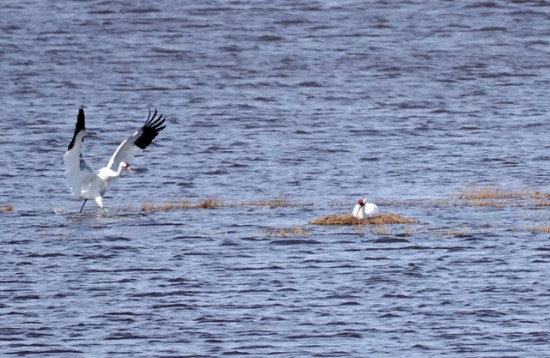
The pair re-nested and were incubating their second nest when seen on Bev Paulan’s May 12 flight.
Spring 2017: In early June, chick W14-17 hatched to parents 9-03 and 3-04. Unfortunately, W14-17 was last seen in mid-July and did not fledge.
Fall 2017: On November 2, 9-03 and 3-04 were sighted at their normal wintering grounds in Wayne County, Illinois. On January 3, they were sighted at Wheeler National Wildlife Refuge in Alabama. They often move south to Wheeler as temperatures drop in Illinois.
Spring 2018: 9-03 and 3-04 migrated back to Necedah and were nesting in early April, but their first nest was abandoned due to a late snowstorm. In mid-May 3-04 was seen on their new nest, and in early June, chicks W7-18 and W8-18 hatched two days apart! Unfortunately, neither chick survived the summer.
Fall 2018: On October 21, 9-03 and 3-04 were confirmed to be on their normal winter grounds in Wayne County, Illinois.
Spring 2019: Trackers confirmed 9-03 and mate 3-04 had returned to their Necedah National Wildlife Refuge territory by early April
9-03 and 3-04 began nesting on April 16. However, their first clutch of eggs was removed for the forced renesting program on April 20.
The pair renested and began incubating their second nest on May 9. Two chicks hatched from the nest in early June, W16-19 and W17-19. W17-19 was not seen on pilot Bev Paulan’s June 20 flight.
Sadly, in early July, 9-03 was found dead near her mate and chick. Cause of death was predation.
Click here to jump to the top of this page.
Crane #10-03
Sex: Male
Hatch Date: May 6, 2003
Personality Characteristics: Aggression issues with #11-03. Separated upon arrival at Necedah so they could socialize through a fence without harming each other. Despite initial aggression problems with #11-03, the two now hang together and #10-03 is torn between following the aircraft and staying with #11-03, who is aloof and standoffish to the costumed handlers. By October, this bird was beating up on everybody, and might be the top bird (or close to top) in the flock. He is always in the training group that’s flying without problems turning back or dropping out. Acquired adult voice week in Jan., 2004.
First Migration South: Turned back and landed at Necedah on day 1 of the migration along with #2-03, #11-03 and #13-03. Crated and transported to first stopover. Flew all but about 33.1 miles of the migration, missing a leg (a day’s flight) in TN.
History
Spring 2004: Left Chassahowitzka together with the other 7 remaining chicks on April 7 at 9:10 a.m. They flew until rain stopped them, landing in Jefferson Cty., FL at 3:35 where they roosted that night. Took off April 8 in the group of 8 but a thunderstorm separated the cranes into 3 groups. #13-03 and #10-03 were later found by a pond in a s. Georgia pasture–within 3 miles of the southward migration route! Cranes #10-03 and #13-03 were not tracked on Apr. 10 or 11. Next reported in Illinois on April 16 and at a small pond in northwest Iowa on April 17. Arrived at Necedah NWR with #13-03 on April 19.
Fall 2004: #10-03 and #13-03 began migration from Juneau County, WI on Nov 7 and flew to Kankankee Cty., IL. They were next tracked on Nov. 15 in Nelson County, Kentucky where they remained at least through December 5. They were no longer at this site when it was checked on Dec. 15. Next located with #2-03 and #13-03 during an aerial survey by Lara Fondow on January 18, 2005 in a managed wetland in Colleton County, South Carolina.
Spring 2005: Began migration March 20 together with #2-03 and #13-03. Reported wandering in Michigan with #13-03 the first half of April. Joe Duff says, “They are far enough south that they could circumnavigate Lake Michigan and make it home, but none of us holds out much hope.”They were last detected in flight in southeastern MI from tracking aircraft on the west side of Lake Michigan on 14 April. Finally, the best news of all: the wandering #2-03 and #13-03 arrived on Necedah National Wildlife Refuge (NWR) on May 21! Moved from Necedah October 16 to nearby Mill Bluff State Park, often seen with other whooping cranes in the area.
Fall 2005: Began migration on November 21. He was reported several times in Colleton County, South Carolina, where he spent last winter.
Spring 2006: Departed South Carolina March 9. Back at Necedah NWR in Wisconsin by March 31.
Fall 2006: Departed Wisconsin on Nov. 19 (with #2-04, #3-04 and #12-04) and made it that night to NE Illinois. Successfully migrated to his winter territory in Colleton County, South Carolina.
Spring 2007: Left SC winter home on March 9 and arrived on Necedah NWR by March 19. His nonfunctional transmitter was replaced on August 30, 2007.
Fall 2007: Crane #10-03 and female #1-05 left Necedah NWR on migration November 22 and made it to Jasper-Pulaski wildlife area in Indiana that day. They continued into Kentucky on November 23. The next day they migrated through northern Georgia. They were found on their old territory in Colleton County, South Carolina, on November 30.
Spring 2008: Confirmed back at Necedah NWR March 29, 2008 with mate #1-05. On April 4, their pair bond was broken by DAR #27-06 (DAR male). Crane #10-03 was determined not to be alone. He displaced #7-03, who had just paired with W1-06, and now #10-03 and W1-06 are together on what was #1-01’s territory until #7-03 and W1-06 drove him away! (Confused? Everyone else is, too — but such antics are normal for a crane’s first few years.)
April 9, 2008: Male #10-03 and wild-born female W1-06 built a nest together. Female W1-06 is too young to lay eggs, but building a nest together signifies a strong bond. They visit cornfields off the refuge, but they always return to the refuge at night. Maybe they’ll become parents in another year or two.
August 2008
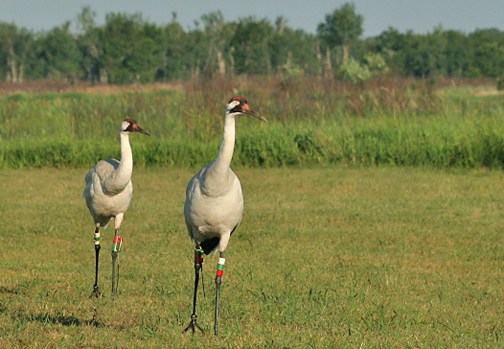
Wild-hatched female #W1-06 and ultralight plane-led male #10-03 are a pair.
Photo: Operation Migration
Male 3-10 and female #W1-06 liked to hang around the training strip as the class of 2008 was learning to fly with the ultralight plane.Fall 2008: Began migration from Wisconsin on November 17, along with mate W1-06 and 12 other Whooping cranes.They were detected in flight while migrating over Perry County, Indiana, on December 7. The pair arrived on #10-03’s previous wintering area in Colleton County, Georgia on December 17.
Spring 2009: #10-03 and mate W1-06 left their South Carolina winter territory during March 11-16. They were reported in Fountain County, Indiana, March 18-21. They completed migration to Necedah NWR in Wisconsin March 23. Sara Zimorski reported, “Apparently #7-03 has been trying (and may have succeeded) to steal W1-06 away from #10-03. Last year #7-03 and W1-06 were hanging out together before #10-03 came along so we’ll see what happens.” In April #10-03 and W1-06 built a nest. Nothing happened with it, and the pair remained together in the core area all summer.
Fall 2009: Male #10-03 and mate W1-06 began migration November 26 along with several other whoopers. These two were located at a previously used stopover on a reclaimed surface mine in Indiana, on November 28 for an extended stay. They were confirmed on their wintering territory in Colleton County, on January 5.
Spring 2010: Pair #10-03 and W1-06 were no longer detected on their wintering area after March 1. Male #10-03 was reported back on Necedah NWR on March 22, and W1-06 (later confirmed on March 28) presumably arrived with him. The pair were observed on a nest during an aerial survey on April 5! They ended up with two failed nests this season, but trackers rescued both eggs from nest #1. Both eggs hatched at Patuxent (MD) Wildlife Research Center.
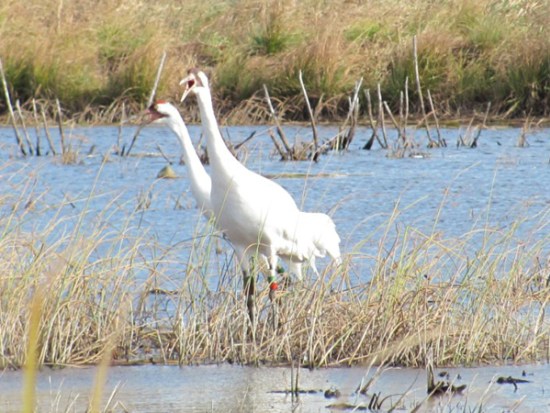
#10-03 and #W1-06 alarm calling in fall 2010. Photo Eva Szyszkoski
Fall 2010: Male #10-03 and female W1-06 began migration on November 20. They were found east of Terre Haute, Indiana on November 24 and stayed there at least through December 11. They were next reported on their usual wintering territory in Colleton County, South Carolina, on January 5.
Spring 2011: Last detected in Colleton County SC on Feb. 19, migrating pair #10-03 and W1-06 was in Parke County, IN at least through March 16. They completed migration to their territory on Necedah NWR, by March 25. By April 8 the pair was incubating on a nest and a chick was announced on May 9! Sadly, the chick went missing after a few days and may have been taken by a predator. The pair did not attempt a second nest this summer.
Fall 2011: #10-03 and W1-06 wintered in Clay and Vigo Counties, Indiana.
Spring 2012: ICF tracker Eva did not hear #10-03’s signal when she heard the signal of his mate, W1-06, in flight over ICF in Baraboo, Wisconsin on March 15. She was concerned, especially when his mate W1-06 was seen on Necedah NWR in active flight with another female. It was a surprise and a big relief when #10-03 showed up on March 17; no one knows where he had been and why he wasn’t with his mate. The pair had a nest together as of April 14! On the April 26 survey flight, they were off the nest and it appeared from photos that the nest was empty and had failed. No chicks for this pair in summer 2012.
Fall 2012: ICF tracker Eva detected Crane #10-03 and mate W1-06 at a migration stopover location in Vigo Co, Indiana on November 1.
Spring 2013:#10-03 and mate W1-06 completed spring migration March 30. By late April or early May they were reported nesting, but the nest soon failed and they did not attempt another nest this summer.
Fall 2013: ICF tracker Eva reported that two cranes, very likely #10-03 and mate #W1-06, were reported in Clay County, Indiana on November 16. They continued migration next from Vigo County, Indiana to Meigs County, Tennessee and arrived at a previous wintering location in Colleton County, South Carolina in early January.
Spring 2014: Pair #10-03 and W1-06 were last observed on their wintering territory in the ACE Basin of South Carolina on 21 February and had returned to Necedah NWR by March 31. However, everything changed after the return. Female W1-06 paired with a new mate, #1-10, while male #10-03 paired with #34-09 (1-10’s former mate).
Fall 2014: ICF tracker Eva took this photo of #10-03’s September 16 capture for transmitter replacement. It was a chance for biologists to perform a brief health exam, including checking the condition of the wing feathers. “This helps us get a better understanding if the bird has recently molted or not,” explains Eva. “Birds with clean, intact feathers may have molted that year while birds with ratty, dirty feathers probably have not. Whooping cranes do a complete molt every 2-3 years, meaning that they lose all their flight feathers all at once. This is a dangerous time for them since they are completely flightless for about 6 weeks. They need to be in an area with stable water conditions so they can remain safe from predators.”
Some birds also have abnormal bumps or leg thickenings due to the healing process from a previous injury.” Captures help us keep records of these abnormalities and we are able to monitor them over time,” explains Eva.
Unfortunately, crane #10-03 did not live to migrate this fall. His heavily scavenged remains were collected on his summering territory on Necedah NWR on October 24, 2014. The photos are now part of important health records kept over time by the WCEP experts.
Click here to jump to the top of this page.
Crane #11-03
Sex: Male
Hatch Date: May 6, 2003
Personality Characteristics: He and #10-03 hated each other and were separated upon arrival at Necedah so they could continue to socialize through fence without harming each other. They got along better later. On 6/23 this crane watched #7-03 work hard to kill a garter snake–and then he stole it away from #7-03 and swallowed it whole. Occasionally prefers to wander off into the marsh during training. Has made great progress, after a rough start when he ignored the aircraft and handlers. They spent much time with #11-03 to improve his performance. Since then he has discovered the wing vortices (air currents that help him fly) and is a great follower. Acquired adult voice in Jan., 2004.
First Migration South: On day one of the migration south, he turned back to the pen at Necedah and was trucked to the stopover site along with #2-03, #10-03 and #13-03. On day two he kept turning back. Brooke convinced the wayward crane to stick with him, and then the bird didn’t want to land! He kept circling and flying until eventually Brooke and Joe both went to chase him down. Joe caught up and guided the bird to a landing next to the temporary enclosure with the others. Made the entire leg to the 3rd location, but once again was reluctant to land. Missed a total of 86.3 miles (TN).
History
Spring 2004: Left Chassahowitzka together with the other 7 remaining chicks on April 7 at 9:10 a.m. They flew until rain stopped them, landing in Jefferson City., FL at 3:35 where they roosted that night. Took off April 8 in the group of 8 but a thunderstorm separated the cranes into 3 groups. Cranes #2-03, #7-03 and #11-03 –each now traveling solo–were located by radio signals April 9 in Georgia after each gaining about another 100 miles. On April 10, #11-03 left his roost in Gwinnett County, Georgia, at 8:55 a.m. and landed to roost in east-central Tennessee at 3:45 p.m. Detected April 14 in KY, April 15 in IN and April 16 in south-central Wisconsin–and April 18 very near Necedah NWR–first of the 2003 chicks to arrive! (He didn’t actually return to the refuge itself until May 1.) He then settled in a favorite spot about 12 miles to the south, and only visited the refuge briefly again in mid-May.
Fall 2004: Left Necedah NWR on Nov. 5 with #4-03 and flew to Kankakee Cty, IL. Still together, #4-03 and #11-03 arrived late Nov. 10 in Washington County, Georgia. On Nov. 18, they were found in Glynn County, Georgia. Verified near McIntosh, Liberty County, GA on November 24th. Next located on Dec. 18 during an aerial-radio search in an area about 14 miles south of crane #17-03 in southeast South Carolina. Remained there in a Wildlife Management area with #4-03.
Spring 2005: Not at the roost site on March 30. Possibly gone on migration with #4-03. Cranes #11-03 and #4-03 joined with chick #12-04 over Indiana on April 6th! They were tracked into WI, where they were in Sauk County on April 7.
Fall 2005: Began migration Nov. 17 with #1-03. They later joined in flight with #2-01, #12-02, #3-02 and #17-03. The group roosted that night in Will County, IL. They flew Nov. 18 to SW of Indianapolis, Indiana. They were all still at this Marion County, IN stopover site in mid-December. On Dec. 20, a pair of whoopers that might have been #1-03 and #11-03 were sighted on Colleton County, SC. The pair arrived at the Chassahowitzka pen site on Dec. 22. They remained in the pen area and made several short flights in the next few days.
Spring 2006: Still in SC on March 23 but this bird (with #1-03??) may be one of the two reported back in Michigan April 2. This was the same general area occupied by#1-03 and #18-03 in 2004 and 2005 before the latter two birds were retrieved and re-released in Central Wisconsin early last summer (2005).
Fall 2006: He was captured in October to have his radio transmitter replaced. He and mate #1-03 began migration Nov. 19 and made it to Kankakee County Illinois that night. They successfully migrated to their winter territory in Colleton County, South Carolina.
Spring 2007: Left SC on migration (with #1-03) on March 24. He and mate and #1-03 arrived on their territory on Necedah NWR on March 29. Sadly, in September his mate was found dead (apparently killed by a raptor).
Fall 2007: On September 29 male #11-03 left the territory he shared with his mate (killed September 28) and did not return. His signal was detected from an aircraft (not a tracking flight) on October 3 in Green Lake County, Wisconsin, but no signals were detected during a ground search the next day. Also not found during aerial search on October 10, but was later found with #12-03 on winter territory in Colleton County, South Carolina.
Spring 2008: Crane #11-03’s arrival date is probably the same as mate #12-03. ICF tracker Colleen reported: On April 8, I was listening to #12-03’s signal, hoping to see her and, especially, her mate, #11-03. He has a non-functional transmitter. As I was driving along the road, I saw what looked like a Whooping Crane, and then a second one. I took out my binoculars, and sure enough, they were two Whooping Cranes. Then I used my spotting scope to look at the leg bands. I was very excited to confirm #11-03 and #12-03 and to see that they were still together and safely back at Necedah.”
May 5, 2008
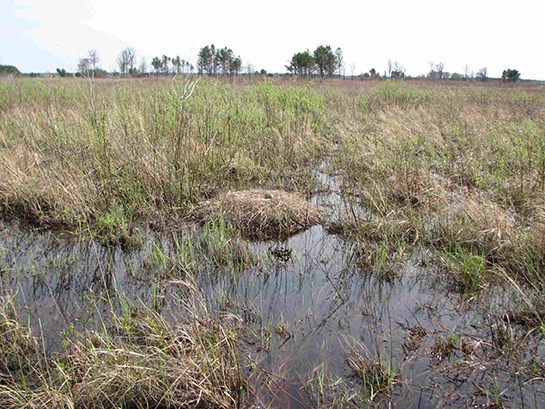
The pair began incubating on a nest around April 16! But the nest, with an intact fertile egg, failed in early May. The good egg was collected and brought to ICF for incubation, so all is not lost.
Fall 2008: Began migration (with #12-03) from Necedah NWR on November 15, as did other first cranes to leave. The pair arrived on their wintering grounds in Colleton County, South Carolina, a week later!
Spring 2009: Began migration from Colleton County, SC, on March 17 or 18 with #12-03. They were detected in flight in Indiana (by #12-03’s transmitter signal) on their way to roost in Vermillion County, Illinois, on March 21. Biologists detected the signal of mate #12-03 at Necedah NWR the end of March, so assumed that #11-03 was also back. A week later #11-03 was also confirmed. The pair nested but the nest failed on the same day that black flies tormented several other nesting crane pairs off their nests. The pair remained together in the core area all summer.
Fall 2009: Pair #11-03 and #12-03 left Necedah NWR on migration November 26. They migrated as a group with several other departing Whooping cranes before landing to roost at an undetermined location(s) in Illinois. The pair was next detected Nov. 29 migrating through Tennessee, where they landed to roost on Hiwassee Wildlife Refuge. They were on their previous wintering territory in Colleton County, SC by Dec. 3.
Spring 2010: Pair #11-03 and #12-03 began migration from South Carolina on March 15. They were reported back on Necedah NWR by March 26. On a nest survey flight in early May, tracker Eva suspected and later confirmed a nest by this pair in a remote area of the refuge. The nest was begun sometime between May 9 and 12, and the pair was still incubating as of May 28! On the weekend of June 12-13, Matt Ahrens, Operation Migration pilot and Matt Strausser, ICF tracker spotted a new chick with #11-03 and #12-03 while on a nesting survey flight. The pair’s second egg never hatched, but chick W7-10 probably hatched June 11. Within a few days the family moved eastward from the nesting marsh to a pool and favorite feeding area of the adults. Unfortunately, the chick disappeared between July 3 and 6.
Fall 2010: Pair #11-03 and #12-03 began migration Nov 17 and wintered on their usual territory in Colleton County, South Carolina.
Spring 2011: Pair #11-03 and #12-03 began migration from their South Carolina winter territory after March 4 and were back at Necedah NWR by March 21. They began incubating a nest on April 14. This nest failed May 8 and no eggs were salvaged.
Fall 2011: Pair #11-03 and #12-03 migrated to Colleton County, SC for the winter.
Spring 2012: Male #11-03 was assumed to be with his mate #12-03 when she was reported on Necedah NWR on March 16. The pair had a nest by April 25, but the nest had failed by May 7.
Male #11-03 was found dead by Bev Paulan (Wisconsin DNR pilot) during an aerial survey over the Necedah National Wildlife Refuge on May 31, 2012. His carcass will be examined to determine cause of death.
Click here to jump to the top of this page.
Crane #12-03
Sex: Female
Hatch Date: May 14, 2003
Personality Characteristics: Just a good bird with no bad habits and a good follower. Certainly no wimp! Fairly dominant. Challenges costumed “strangers,” such as visiting veterinarians or aviculturists. Likes to be part of the group during flights. Gets anxious if she is a lone crane with one of the ultralights, and keeps glancing at the main flock as if she would prefer to join them. Acquired adult voice first week of Feb., 2004.
First Migration South: Flew all but 33.1 miles (TN).
History
Spring 2004: Began first migration north at 9:33 a.m. March 30, 2004 in a group of eight 2003 flock mates (#1-03, #3-03, #5-03, #9-03, #12-03, #16-03, #18-03, #19-03). On April 9 the group separated south of Celina, Ohio. Birds #3-03, #12-03 & 16-03 retreated eastward, toward the location they had just left. On April 11 Cranes #3-03, #12-03 & #16-03 were observed feeding in a cornfield in west-central Ohio. They remained until April 24, when the three headed north. On April 25th they continued northwest and encountered Lake Michigan on an unfamiliar side at exactly the same point that the group of five had two weeks earlier. Cranes #3-03, #12-03 & #16-03 remained together in Michigan, confused by how to get around the huge obstacle of Lake Michigan. In April, crane #12-03 was injured by an aluminum can top that became stuck around her bill, preventing eating or drinking.
This is the ragged top of the aluminum can that was stuck on #12-03’s mandibles. Photo: Richard Urbanek
Tracker Richard Urbanek discovered the alarming situation. He quickly donned a costume and captured, helped, and released her. She recovered well. They arrived in central Wisconsin on July 26 and were discovered near Necedah National Wildlife Refuge on July 28, finally completing their interrupted migration!
Fall 2004: Cranes #3-03, #12-03 and #16-03 left Necedah Nov. 20 and flew to Jefferson Cty., WI. On Nov 22 they were in Cook County, IL. Stayed in LaPorte County, Indiana from Nov. 22 until resuming migration on Dec. 18-20. They roosted in or near Fairfield County, South Carolina, on Dec. 22nd, then moved to Marion County, FL. for several days. They arrived at the Chassahowitzka pen site at midday on Jan. 2nd, roosting that night near the constructed oyster bar in the pen. They were the first HY2003 whooping cranes to return to the Chassahowitzka pen site after fall migration. Spent much of the winter on a horse farm in central FL.
Spring 2005: #3-03, #12-03 & #16-03 departed on migration from Marion County, FL on March 20. Will they go back to MI or WI? PTT readings for #12-03 showed the group roosted in southern IN–on the correct migration route–on March 20! The three were reported back in Necedah area March 30. Cranes #12-03 and #16-03 continued to hang out together near Necedah NWR and nearby counties.
Fall 2005: She and #16-03 were not found in their usual area on Nov. 17, a day when 18 whoopers began migration from the area. They showed up with sandhill cranes at other spots in the next few days and likely began migration on Nov. 24. On Dec. 1 they arrived and stayed in Marion County on Florida’s Gulf Coast north of the pen for ultralight-led chicks at Chassahowitzka NWR!
Spring 2006: She and #16-03 likely began migration from Marion County, FL on March 1. Although #16-03 was home in Wisconsin on March 17, #12-03 didn’t return till later.
Fall 2006: Began fall migration from the Wisconsin summer home on Nov. 30 with #16-03 and young DAR (Direct Autumn Release) cranes #27-06 and #32-06. An ICF tracking intern tracked the four cranes to Kendall County, Illinois that night. These birds were one of the last groups to leave Necedah NWR. Cranes #12-03 and #16-03 have been together ever since they were chicks and migrated north together in spring 2004. They were in Alachua County, FL in December.
Spring 2007: Began migration March 5 (with mate #16-03 and pair #3-03 and #17-03). Detected (with mate #16-03) in flight in Wisconsin on March 23. They apparently arrived home in Juneau County later that day.
Fall 2007: Began migration on November 12 with mate #16-03. They were tracked into northeastern Illinois before the ground tracker lost signals. A pair of unidentified whooping cranes, was reported in Colleton County, South Carolina, since November 16. It was determined in late December that #12-03 was now with #11-03.
Spring 2008: Confirmed back on Necedah NWR March 30. Cranes #11-03 and #12-03 began incubating around April 16! They failed to hatch the egg, but one fertile, intact egg was collected from the failed nest on May 5 and brought to ICF for incubation.
Fall 2008: Began migration (with #11-03) from Necedah NWR on November 15, as did other first cranes to leave. The pair arrived on their wintering grounds in South Carolina a week later!
Spring 2009: Began migration from Colleton County, SC, on March 17 or 18 with #11-03. They were detected in flight in Indiana (by #12-03’s transmitter signal) on their way to roost in Vermilion County, Illinois, on March 21. Biologists detected her signal at Necedah NWR the end of March, and assumed that her mate #11-03 was also back. The pair nested in April but the nest failed on the same day that black flies tormented several other nesting crane pairs off their nests. The pair remained together in the core area all summer.
Fall 2009: Pair #12-03 and #11-03 left Necedah NWR on migration November 26. They migrated as a group with several other departing Whooping cranes before landing to roost at an undetermined location(s) in Illinois. The pair was next detected Nov. 29 migrating through Tennessee, where they landed to roost on Hiwassee Wildlife Refuge. They were on their previous wintering territory in Colleton County, SC by Dec. 3.
Spring 2010: Pair #11-03/#12-03 began migration from South Carolina on March 15. They were reported back on Necedah NWR by March 26. On a nest survey flight in early May, tracker Eva suspected and later confirmed a nest by this pair in a remote area of the refuge. The nest was begun sometime between May 9 and 12, and the pair was still incubating as of May 28! On the weekend of June 12-13, Matt Ahrens, Operation Migration pilot and Matt Strausser, ICF tracker spotted a new chick with #11-03 and #12-03 while on a nesting survey flight. The pair’s second egg never hatched, but chick W7-10 probably hatched June 11. Within a few days the family moved eastward from the nesting marsh to a pool and favorite feeding area of the adults. Unfortunately, the chick disappeared between July 3 and 6.
Fall 2010: Pair #12-03 and #11-03 began migration Nov 17 and wintered on their usual territory in Colleton County, South Carolina.
Spring 2011: Pair #12-03 and 11-03 began migration from their South Carolina winter territory after March 4 and were back at Necedah NWR by March 21. They began incubating a nest on April 14. This nest failed May 8 and no eggs were salvaged.
Fall 2011: Pair #12-03 and #11-03 migrated to Colleton County, SC for the winter.
Spring 2012: Pair #12-03 and #11-03 were both assumed to be back on Necedah NWR when her signal was reported on March 16! The pair had a nest by April 25, but it had failed by May 7. It was sad news when her mate was found dead on the refuge on May 31. Over the summer, she took a new mate in Crane #29-09.
Fall 2012: New pair #12-03 and #29-09 were detected at a usual migration stopover in Vigo County, Indiana on November 1.
Spring 2013: Female #12-03 arrived March 28 on Necedah NWR but tracker Eva did not detect her mate #29-09, so either his signal is not working or he didn’t arrive with her. In mid-April she was seen alone, still without male #29-09.
Fall 2013: Female #12-03 was likely among seven Whooping Cranes reported in Rutherford County, Tennessee, on January 24 and in a group of seven reported in Franklin County, Tennessee, on January 29. “We assume these are the same birds,” said ICF tracker Eva Szyszkoski. “Based on band reports they are likely birds #12-09, #12-03/#29-09,#18-09/#35-09 and #10-09/#17-07, although not all have been confirmed yet.”
Spring 2014: Female #12-03 arrived March 28 on Necedah NWR. She paired with #12-05 and the pair nested. However, they abandoned their nest (with two eggs) sometime in May.
Fall 2014: Female #12-03 and mate #12-05 likely departed Necedah on Oct. 31 and migrated south. They wintered in Knox County, Indiana.
They were photographed in Knox Co., IN on Feb. 25, 2015 by Mark Crowley
Spring 2015: Female #12-03 returned to Necedah NWR by March 30 with a new mate (#29-09). They nested and their first eggs were removed April 16 as part of the forced renesting effort and she laid more eggs in a second nest. A chick hatched about June 2. It was still alive as of June 23, but did not survive to fledge. Fall 2015: Female#12-03 and #12-05 were confirmed in Knox County, Indiana by November 13.
Spring 2016: Female #12-03 (and this time male #29-09) was observed on territory in Wisconsin by Bev Paulan’s March 30 aerial survey flight. The new pair’s first nest failed but they were sitting on a second nest by May 6. Their first chick, W7-16, hatched on May 24 and second chick, W8-16, on May 25. Both chicks were still alive on the June 7 aerial survey but only W7 survived and was flying short distances near its parents by Aug. 4 (photo). The chick was still alive in September, and by then was the single surviving chick of the 2016 breeding season. Unfortunately, W7-16 was killed by a predator in October.
Fall 2016: Pair #12-03 and #29-09 migrated south to Greene County, Indiana in early November.
Spring 2017: Female #12-03 and mate #29-09 were back on their Necedah NWR territory and nesting by early April. They re-nested and were incubating their second nest when seen on Bev Paulan’s May 12 flight. Chick hatched! W13-17 hatched approximately June 6th and as of July 5th is still alive.
Summer 2017: Unfortunately, W13-17 was last seen in mid-July, and did not survive the summer.
Fall 2017: On November 2, 12-03 and 29-09 were seen at the normal wintering grounds at Goose Pond Fish and Wildlife Area in Indiana.
Spring 2018: In late February 12-03 was seen at Goose Pond without mate 29-09. 12-03 migrated back to Wisconsin with male 10-09, but the pair did not nest. 12-03 was seen alone at Necedah Wildlife Refuge on April 26.
Fall 2018: In late October, 12-03 was seen in Knox County, Indiana with male 12-05. These birds have been together before- maybe they’ll stay together and nest this time!
Spring 2019: 12-03 and mate 12-05 had returned to their territory at Necedah National Wildlife Refuge by mid-April
12-03 and 12-05 were first seen sitting on a nest April 16 by pilot Bev Paulan, but the eggs were removed on April 20 as part of the forced renesting program.
On May 4, Bev saw them sitting on a renest. In early June, chick W14-19 hatched! The chick was banded, and blood tests revealed she was a girl. W14-19 fledged at the end of August.
Fall 2019: 12-03 and mate 12-05 were together for the summer on their territory at Necedah National Wildlife Refuge. They migrated south with their chick W14-19 and arrived on their wintering grounds in Knox County, Indiana mid-November. They remained here for the winter until the end of March.
Spring 2020: 12-03 and 12-05 were first observed back at Necedah National Wildlife Refuge at the end of May with a new chick, W14-20! As of July, the chick is still alive.
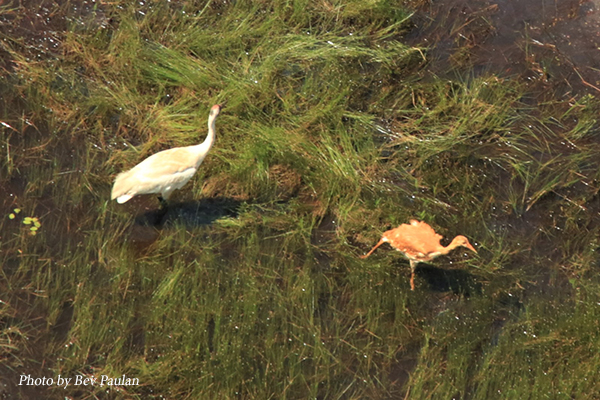
Fall 2020: 12-03 and 12-05 fledged a chick in 2019 and now another in 2020, W14-20. They are on a roll! W14-20 fledged at the beginning of August. She and her parents left Necedah NWR, WI in late October. They were seen in Winnebago County, IL on their way down to their normal wintering spot in Knox County, IN.
Spring 2021: 12-03 and 12-05 migrated north in early March. Once at Necedah National Wildlife Refuge, they got right to work and were incubating by mid-April. Their nest was successful and W10-21 is doing well as of July 2021!
Fall 2021: This fall and summer 12-03, 12-05, and chick W10-21 were hiding out deep in the marshes of Necedah NWR. The family was last spotted in WI on August 19th. Despite numerous efforts to locate the family, they weren’t seen again until they migrated to Knox County, IN in early November. Unfortunately, the pair arrived on their wintering grounds without W10-21.
Spring 2022: 12-03 and 12-05 began migrating north in mid-March and were spotted back at Necedah National Wildlife Refuge in early April. They were seen incubating in mid-April, but the eggs from this nest were collected as part of a forced renesting program, which helps the pair avoid black flies and nest again when black flies are gone. The pair sat full term on their second nest, but unfortunately the egg did not hatch.
Fall 2022: 12-03 and 12-05 spent the summer on their territory at Necedah NWR and migrated south during mid-October. They arrived on their usual wintering grounds in Knox County, Indiana one day after leaving Wisconsin.
Spring 2023: 12-05 and 12-03 migrated in late March from their wintering grounds in Knox County, Indiana, to their territory at Necedah NWR and were spotted with a nest. The eggs in their first nest were collected as part of a renesting program to help nesting pairs avoid biting black flies and renest when the black flies are gone. Both eggs from their first nest were sent to the reintroduced Whooping Crane population in Louisiana. After the pair renested, they laid two eggs, and one was collected for our captive rearing and release program. Given that Whooping Cranes typically raise one chick a year, this allows us to further increase the number of Whooping Cranes entering the population in one season. The egg collected from their second nest hatched at the International Crane Foundation and will be released back into the Eastern Migratory Population!
Fall 2023: 12-03 and 12-05 spent the summer on their territory at Necedah NWR and began their migration in mid-October. The two made it to their typical wintering grounds in Knox County, Indiana, where they have been foraging and exploring their familiar grounds ever since.
Click here to jump to the top of this page.
Crane #13-03
Sex: Female
Hatch Date: May 17, 2003
Personality Characteristics: Large, aggressive, dominant female who often chases off the big white older cranes from the 2001 and 2002 ultralight groups. Feisty with costumed handlers. Like to assert authority. Turned back and landed at Necedah on day 1 of the migration along with #2-03, #10-03 and #11-03.
Migration South: Flew every mile with the ultralight!
History
Spring 2004: Left Chassahowitzka together with the other 7 remaining chicks on April 7 at 9:10 a.m. They flew until rain stopped them, landing in Jefferson City., FL at 3:35 where they roosted that night. Took off April 8 in the group of 8 but a thunderstorm separated the cranes into 3 groups. #13-03 and #10-03 were later found by a pond in a south Georgia pasture–within 3 miles of the southward migration route! Next reported in Illinois on April 16 and at a small pond in northwest Iowa on April 17. Arrived home at Necedah NWR April 19 with #10-03.
Fall 2004: #10-03 and #13-03 began migration from Juneau County, WI on Nov. 7 and flew to Kankankee Cty., IL. They were next tracked on Nov. 15 in Nelson County, Kentucky where they remained at least through December 5. They were no longer at this site when it was checked on Dec. 15.The three birds were next located together during an aerial survey by Lara Fondow on January 18, 2005 in a managed wetland in Colleton County, South Carolina.
Spring 2005: Began migration March 20 together with #10-03. The two were reported wandering in Michigan the first half of April. Joe Duff says, “They are far enough south that they could circumnavigate Lake Michigan and make it home, but none of us holds out much hope.” Cranes #10-03 and #13-03 were detected in flight in SE Michigan from tracking aircraft on the west side of Lake Michigan on 14 April. And then—surprise! On May 21 #10-03 and #13-03 arrived on Necedah National Wildlife Refuge (NWR). She was seen several times with #8-02 during the summer.
Fall 2005: Began migration on Nov. 24 with #5-02. Migrating together, they reached #5-02’s former winter home on a Pasco County ranch in Florida, on December 1. By the end of December, at least 100 sandhill cranes were there along with whooping cranes#2-01, 12-02, #8-02,#5-01, and #4-02. The pair (#5-02/#13-03) unison-called when the newly arrived whooping cranes flew over them.
Spring 2006: Crane #13-03 (together with #5-02) began migration from a cattle ranch in Pasco County, Florida on February 28. A pair of cranes reported March 3 in Indiana could have been this pair. They were confirmed home in Wisconsin March 17.
Fall 2006: With her mate #8-02, she was one of the last whooping cranes to leave Wisconsin’s Necedah NWR in November. The pair was at a migration stopover in Greene County, Indiana for an extended time, and her mate was found under a power line on Dec. 23. He was rescued and taken for medical care but died on Dec. 27, 2006. Crane #13-03 remained at their Indiana stopover site until the first week in February. She moved on when the coldest arctic air mass of the season chilled the Midwest.
Spring 2007: Migrated back to the Necedah National Wildlife Refuge in Wisconsin, probably by March 12, and she was observed with two sandhill cranes on March 15. Later in March she was associating with whoopers #10-03 and 5-02.
Fall 2007: Female #13-03 and male #18-03 left Wisconsin on migration on November 22. They were reported with #6-05 in Alabama on December 27-30. They arrived at their old Florida pen site at Chass on January 5 and roosted there along with #9-03 and #3-04. The group of five moved the next day to Sumter County and moved again on January 7, when they separated in flight. Cranes #13-03 and #18-03 were tracked to Putnam County, Florida, but they continued northward.
Spring 2008: Female #13-03 and her mate (#18-03) began migration March 10 and were tracked to their first overnight migration stop in Madison County, Florida. The pair completed migration back to their territory on Necedah NWR April 3. They built a nest and began incubation on April 13 or 14. On May 6 they abandoned their nest, leaving 2 fertile eggs. The eggs were collected and taken to ICF in hopes they can hatch.
Fall 2008: Began migration from Wisconsin on November 17, along with mate #18-03 and 12 other Whooping cranes. She and mate #18-03 were found in good crane habitat in Bradley County, Tennessee on January 11, 2009.
Spring 2009: Began migration from Bradley County, Tennessee, after March 8. At Green County, Indiana stopover March 10-15. Confirmed back in Wisconsin March 23 with mate #18-03. ICF’s Eva confirmed #13-03 and #18-03 incubating on a nest located on their usual territory on April 7 or before! The nest failed April 19. They re-nested but that nest also failed (May 17). The pair remained together in the area all summer.
Fall 2009: #13-03 and mate #18-03 began migration on November 2 or 3. By Nov. 4 they were reported at a previously used migration stop in Greene County, Indiana. They ended up at their previous wintering area in Bradley County, Tennessee.
Spring 2010: Crane #13-03 and mate #18-03 began migration sometime after Feb. 13, as they were were reported back at a previously used migration stop in Greene County, Indiana, on February 26. They remained there until departure some time between March 18-22. The pair was reported back on Necedah NWR by March 24 and were observed on a nest during an aerial survey on April 5, but the nest failed. They did not try again. Her mate began also spending time with #9-05. However, the pair #13-03/#18-03 was consistently together again by migration.
Fall 2010: Crane #13-03 and mate #18-03 remained on Goose Pond FWA, Greene County, Indiana, at least through the morning of December 22. A pair of Whooping cranes seen in flight just to the south of Goose Pond on the morning of December 25 were likely these birds. They were next reported on their usual wintering territory in Bradley County, Tennessee, on December 30.
Spring 2011: Migrating pair #13-03 and #18-03 were reported in Greene County, Indiana, on February 24. They stayed there at least through March 4. (Compare this with their timing last spring, above!) On March 21 they were in Stephenson Cty, IL. They completed migration to Necedah NWR on March 25.
But then apparently male #9-05 (see spring 2010, above) won female #13-03 away from the mate with whom she had not successfully nested. By April 12, female #13-03 and male #9-05 were incubating on a nest! They hatched one chick (W3-11) on May 10. The chick survived the May 22 tornado in the nesting territory but disappeared on June 10.
Fall 2011: Female #13-03 and new mate #9-05 began fall migration between November 23-27. Their wintering area was unknown to trackers.
Spring 2012: Female #13-03’s mate #9-05 was detected as he arrived back at Wisconsin’s Necedah NWR on March 11, migration complete! Her transmitter isn’t working, but it was assumed that #13-03 was with him. They were found with a nest on April 6 but they later abandoned it. The pair built a second nest and started incubating Aprill 18. This nest was successful! Chick #W8-12 was confirmed on the May 21 tracking flight. Chick W8-12 still survives as of Nov., 2012.
Fall 2012: She was captured Oct. 17 and her transmitter replaced before migration. Her original band colors remain the same. She migrated south with her mate and chick and they were believed to be in Indiana as of Dec. 21, per tracker Eva Szyszkoski.
Spring 2013: On March 30 the family of #13-03, mate #9-05 and last summer’s chick #W8-12, completed their migration north. HOORAY! The pair was already sitting on a new nest by mid April. They abandoned the nest but their two rescued eggs were incubated at ICF and chicks #1-13 and #4-13 hatched to become part of the ultralight-led cohort for the Class of 2013.
Fall 2013: Migrated south with her mate and their chick. The family was believed to be in Indiana as of Dec. 21, per tracker Eva Szyszkoski.
Spring 2014: Pair #13-03 and #9-05 completed migration back to the Necedah NWR on 26 March. The pair nested in Juneau County and were first seen incubating on April 9. They hatched the season’s FIRST chick on May 8 and the second soon after! The first chick was assigned the number W1-14: “W” for a wild chick, 1 for the first hatch of the year, and 14 for the year. The second chick is W2-14. Neither chick survived the summer. However, the parents “adopted” one of the chicks from the parent-reared release program when young female #20-14 was released by them in fall before migration.
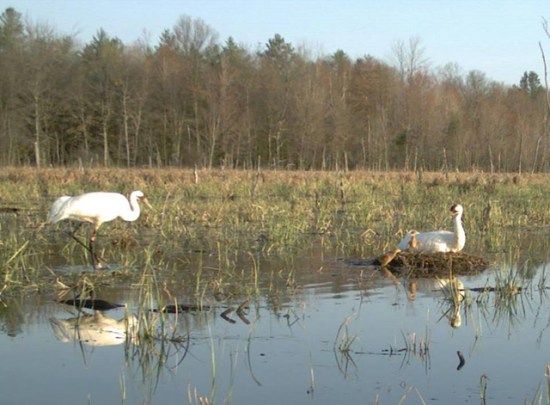
W1-14 & W2-14 with 13-03 (Mom) and 9-05 (Dad)/ Photo: USFWS
Fall 2014: Pair #13-03 and #9-05 and parent-reared chick #20-14 (adopted after their own chicks didn’t survive) migrated together to Greene County, Indiana, departing Necedah on Oct. 31. Well done! These three birds were seen associating with pair #8-04 and #19-05 in December at their Indiana location. Young #20-14 was in Jackson County, Alabama, with her new “parents” all winter.
Spring 2015: The family began migration from Jackson County, Alabama, on March 7-8 with their adopted parent-reared chick #20-14, and the three completed migration back to Wisconsin by March 19. The adult pair nested and on May 3 they hatched the first chick of the season, but the chick soon disappeared.
Fall 2015: Pair #13-03 and #9-05 were confirmed in Greene County, Indiana by Nov. 13, having departed Necedah NWR sometime in the previous two weeks. Several other whoopers from the eastern flock were also in Greene County on that date.
Spring 2016: Pair #13-03 and #9-05 were back at Necedah NWR and already tending a nest with two eggs by April 7! They were the first nesters this season and On May 1-2, hatched two chicks: W1-16 and W2-16! On May 5, Wisconsin DNR pilot Bev Paulan photographed mom #13-03 with both her chicks (below), but neither chick survived the summer.
Fall 2016: Wintered again in Greene County, Indiana.
Spring 2017: Pair #13-03 and #9-05 were back at Necedah NWR and tending a nest by early April. They re-nested and were incubating their second nest when seen on Bev Paulan’s May 12 flight. A chick was spotted by Bev Paulan during her aerial survey on June 7 and Bev noted the chick appeared to be 4 days old.
On the June 15th flight it was still alive, however, by the following weeks’ flight on June 22nd the two adults were seen foraging near their territory and no chick was spotted.
Fall 2017: This pair returned to their wintering grounds in Greene County, Indiana.
Spring 2018: This pair returned to Necedah NWR in April and began nesting. Unfortunately, their nest was lost in a late winter storm with dropped up to 20 inches of snow. There is still time for them to re-nest.
Summer 2018: 13-03 and 9-05 did not renest in 2018.
Fall 2018: Mid-October, 13-03 and 9-05 were sighted on their wintering grounds at Goose Pond, Indiana. They were frequently seen with male 19-10 over the winter.
Spring 2019: Trackers first saw 13-03 and mate 9-05 at Necedah National Wildlife Refuge in early April.
13-03 and 9-05 were first seen incubating a nest by pilot Bev Paulan on April 10. The eggs from this nest were removed as part of the forced renesting program.
On May 3, Bev saw them sitting on a renest, though the nest had failed by May 12.
Amazingly, on May 30, Bev saw them on a nest again! They are only the second pair in the Eastern Migratory Population to nest three times in a season. Chick W19-19 hatched at the end of June, and fledged in September! This is the second chick this pair has raised to fledging.
Fall 2019: 13-03, 9-05, and chick W19-19 migrated together and were first seen at their wintering location of Goose Pond at the beginning of November. They also made a stop in Winnebago County, Illinois on the way. In February, 13-03 was captured and given one of the first new transmitters that sends us GPS locations of her.
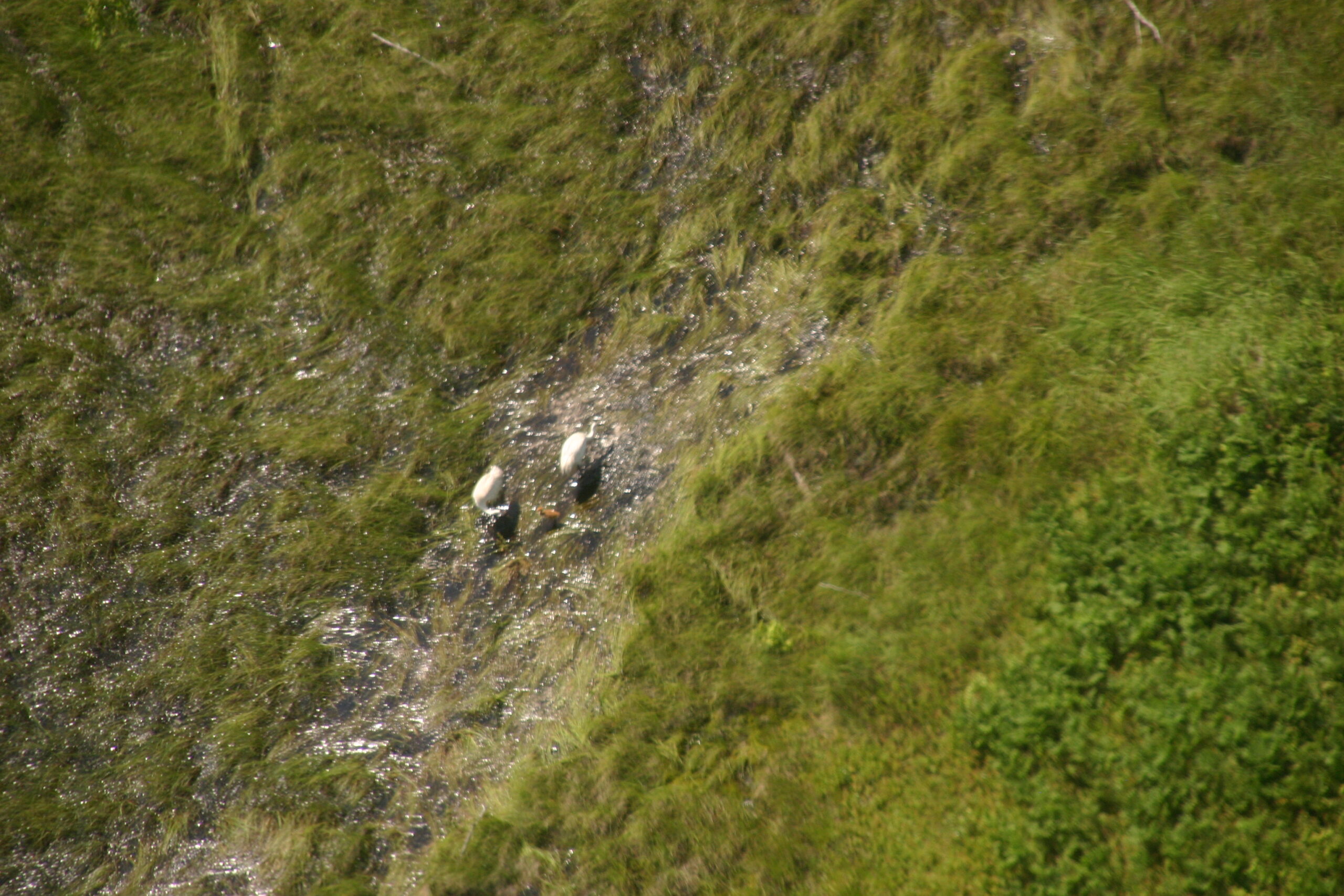
Photo: Bev Paulan
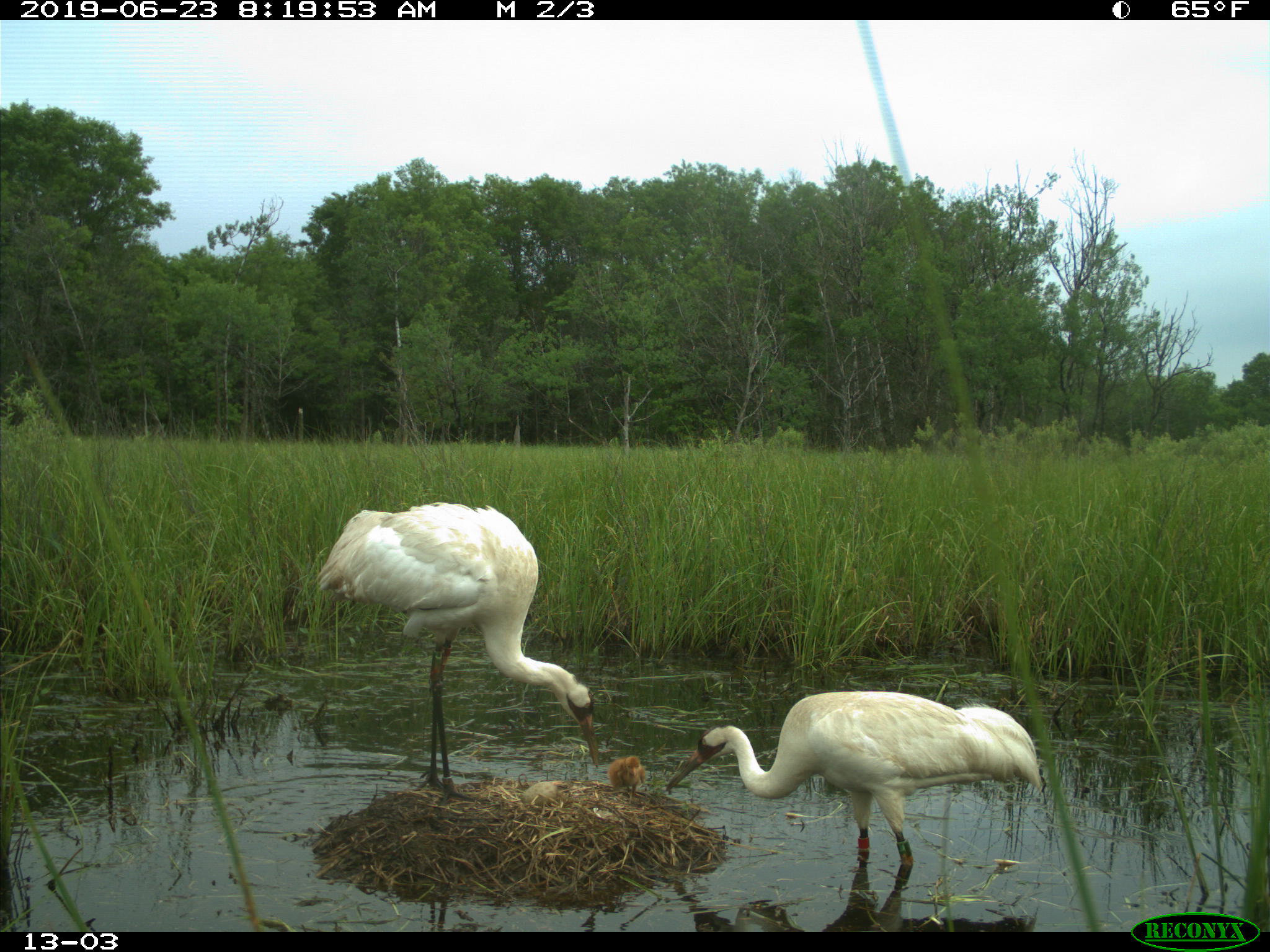
Photo: USFWS
Spring 2020: Looking at the new transmitter data we could see that 13-03 had arrived back at Necedah National Wildlife Refuge on March 27th. They journey up North took about 4 days! Then they began nesting in mid-April and hatched two chicks, W7-20 and W8-20. Sadly, neither of them are still alive. Their chick from last year, W19-19, is still alive and has been seen at Necedah National Wildlife Refuge and seems to be associating with female W3-18 and occasionally male W5-18.
Fall 2020: 13-03 and 9-05 left Necedah NWR in late October and made their way to Goose Pond FWA, Indiana. Their journey took about two days.
Spring 2021: 13-03 and 9-05 migrated north in early March, arriving at their territory in Necedah National Wildlife Refuge, then laid two eggs in late April. Their nest was unsuccessful, but they appeared to be fostering a wayward Sandhill Crane chick for a few weeks in July.
Fall 2021: 13-03 and 9-05 left Necedah NWR in early November. It took them three days to fly from their breeding grounds in Wisconsin to their wintering grounds in Greene County, Indiana.
Spring 2022: Sometime in mid-January 13-03 and 9-05 briefly left their wintering grounds in Greene County, Indiana to spend some time in Jackson County, Alabama. They made their way back to Greene County in February and migrated to their breeding grounds in Necedah National Wildlife Refuge in early April. Eggs from their first nest were collected as part of a forced renesting program, which helps the pair avoid black flies and nest again when black flies are gone. The eggs were sent to Louisiana and hatched in captivity for eventual release back into the wild. During mid-May 13-03 and 9-05 renested and eventually hatched a chick, W11-22!
Fall 2022: Unfortunately, W11-22 was found this summer with a broken wing. The wing was healed in a position that would prevent W11-22 from being able to fly so he was captured and brought to ICF. During fall, 13-03 and her mate 9-05 left their territory at Necedah NWR in early November. They returned to their usual wintering area in Greene County, Indiana.
Spring 2023: After spending some time in Greene County, Indiana, 13-03 and 9-05 briefly left their wintering grounds and flew to Jackson County, Alabama, perhaps in search of some warmer weather! They flew north back to Greene County, Indiana, in March. Unfortunately, this pair has not been seen since returning to Wisconsin this spring, and we hope they will show up somewhere soon.
Fall 2023: 13-03 unfortunately has not been seen since March when she returned to Wisconsin with 9-05. We are still hoping to see the pair on their breeding territory in Necedah NWR this spring!
Click here to jump to the top of this page.
Crane #16-03
Sex: Male
Hatch Date: May 19, 2003
Personality Characteristics: Originally a bit aggressive toward the others. Separated upon release at West site training area to avoid issues. Able to socialize through fence until aggressive tendencies subsided. All of the birds from cohort three are going through their independent stage and often ignore the aircraft and handlers. #16-03 is among the worst. At times reluctant to come out of pen for training, but he follows well once out of the pen. Got a cut on his foot and had to be kept out of water for a time due to infection. The cut healed well with medicine. Attained adult voice in Jan., 2004.
Migration South: Flew all but 33.1 miles (TN).
History
Spring 2004: Began first migration north at 9:33 a.m. March 30, 2004 in a group of eight 2003 flock mates (#1-03, #3-03, #5-03, #9-03, #12-03, #16-03, #18-03, #19-03). On April 9 the group separated south of Celina, Ohio. Birds #3-03, #12-03 & #16-03 retreated eastward, toward the location they had just left. On April 11 Cranes #3-03, #12-03 & #16-03 were observed feeding in a cornfield in west-central Ohio. They remained until April 24, when the three headed north. On April 25th they continued northwest and encountered Lake Michigan on an unfamiliar side at exactly the same point that the group of five had two weeks earlier. Cranes #3-03, #12-03 & #16-03 remained together in Michigan until they finally figured out how to get around the huge obstacle of Lake Michigan. Crane #16-03 later split off in SW Michigan, but later completed his interrupted migration and returned to Necedah NWR on July 28 along with #12-03 and #16-03.
Fall 2004: Cranes #3-03, #12-03 and #16-03 left Necedah Nov. 20 and flew to Jefferson Cty., WI. On Nov 22 they were in Cook County, IL. Stayed in LaPorte County, Indiana from Nov. 22 until resuming migration on Dec. 18-20. They roosted in or near Fairfield County, South Carolina, on Dec. 22nd, then moved to Marion County, FL. for several days. They arrived at the Chassahowitzka pen site at midday on Jan. 2nd, roosting that night near the constructed oyster bar in the pen. They were the first HY2003 whooping cranes to return to the Chassahowitzka pen site after fall migration. Spent much of the winter on a horse farm in central FL.
Spring 2005: #3-03, #12-03 & #16-03 departed on migration from Marion County, FL on March 20. Will they go back to MI or WI? PTT readings for #12-03 showed the group roosted in southern IN–on the correct migration route–on March 20! The three were reported back in the Necedah area March 30, and #16-03 continued to hang out with #12-03.
Fall 2005: He and #12-03 were not found in their usual area on Nov. 17, a day when 18 whoopers began migration from the area. They showed up with sandhill cranes at other spots in the next few days and likely began migration on Nov. 24. On Dec. 1 they arrived and stayed in Marion County on Florida’s Gulf Coast north of the pen for ultralight-led chicks at Chassahowitzka NWR!
Spring 2006: He and #12-03 began migration from Marion County, FL on March 1. No further reports until March 17, when #16-03 was home, near Necedah NWR in Wisconsin.
Adult pair #12-03 and #16-03 on Dec. 2, 2006, in Illinois with DAR #27-06 and #32-06
Fall 2006: Began fall migration from the Wisconsin summer home on Nov. 30 with #12-03 and young DAR (Direct Autumn Release) cranes #27-06 and #32-06. An ICF tracking intern tracked the four cranes to Kendall County, Illinois that night. These birds were one of the last groups to leave Necedah NWR. Cranes #16-03 and #12-03 have been together ever since they were chicks and migrated north together in spring 2004. They were in Alachua County, FL in December.
Spring 2007: Began migration March 5 (with mate #12-03 and pair #3-03 and #17-03). Detected (with mate #12-03) in flight in Wisconsin on March 23. They apparently arrived home in
Juneau County later that day.
Fall 2007: Began migration on November 12 with mate #12-03. They were tracked into northeastern Illinois before the ground tracker lost signals. A pair of unidentified whooping cranes, which may have been this pair, was reported in Colleton County, South Carolina, since November 16, but #16-03 and #11-05 were later on territory in Marion County, Florida.
Spring 2008: Began migration from Marion County,
Florida, on February 24, 25, or 26. Confirmed back on Necedah NWR by March 30.
Fall 2008: Still in WI as of Nov. 26 but observed at Hiwassee Wildlife Refuge in Tennessee Nov. 27-29, and still there Dec. 19. His transmitter does not work so he cannot be tracked.
Spring 2009: Reported at Goose Pond FWA in Greene County, Indiana March 10 through 15. He has a nonfunctional transmitter. On May 6, ICF’s Sara Zimorski and Eva Szyszkoski were thrilled to discover that #16-03 was back in Wisconsin — and he was the “mystery bird” they’d often seen flying with DAR #42-07 since mid-April, but they’d they’d been unable to identify it. When the two birds moved onto a private cranberry farm, Eva and Sara got permission to come onto the farm when the owner called to report the birds were standing in one of the cranberry beds. Eva got a perfect view to observe the birds from a distance and read the color bands on the mystery bird to learn that it’s #16-03. Sara said, “We’re also excited for #16-03 to have a new mate; he lost his mate (#12-03) two years ago after #11-03 lost his mate and proceeded to steal #12-03 away from #16-03.” In late September #16-03 paired with female #1-05 (who had just left male #5-01). It didn’t last long, as they separated on Oct. 24. (#1-05 was back with her old mate, #5-01, two days later.)
Fall 2009: #16-03 was reported with sandhill cranes in Marquette County, WI on November 5-7. He moved to the Lewiston area by November 16 for several days but migrated south. Last observed in Meigs County, Tennessee on January 7, 2010.
Spring 2010: He was reported in Jackson County, Indiana, on February 26 and 28. He had reached Greene County, Indiana, on March 6 and remained there until some time between March 18-22. He was reported back on Necedah NWR by March 28 and observed with female #16-07.
Fall 2010: He was last observed on Sprague Pool, Necedah NWR, on May 6, 2010.
Click here to jump to the top of this page.
Crane #17-03
Sex: Male
Hatch Date: May 20, 2003
Personality Characteristics: Somewhat shy and loves the wet pen so much that he will not come out unless bribed with treats. Seemed low on the pecking order but was more comfortable with the group by end of August. Attained adult voice during the third week of March, 2004.
Migration South: One of the six cranes (with #1-03,#5-03,#19-03, #12-03 and #16-03) that flew the whole first leg. Got tired and dropped out 8 miles short of 4th migration stop, so was crated and transported to location. That’s the only 8 miles of the migration he did not fly.
History
Spring 2004: Left Chassahowitzka together with the other 7 remaining chicks on April 7. They flew until rain stopped them, roosting that night in Jefferson Cty., FL. Took off April 8 in the group of 8 but a thunderstorm separated the eight. Cranes #4-03, #6-03 and #17-03 stayed together, but flying southward. They landed in a north Florida wetland at 4:40 p.m. Cranes #4-03, #6-03 & #17-03 were last detected in flight in northwestern Georgia or northeastern Alabama in late afternoon April 10; in KY April 15, and in IL on April 16. On April 17, #4-03, #6-03 and #17-03 flew for almost 11 hours and landed in SE Minnesota well after darkness fell. This was approximately 65 miles southwest of their Necedah NWR reintroduction site. The three stayed in that MN location until April 23 and were seen flying along the Mississippi River in late April. Next went to Trempeleau County, WI, and were finally reported back at Necedah May 12. Later moved to nearby Mill Bluff State Park with several 2002 ultracranes from the 2002 flock.
Fall 2004: Left Wisconsin October 23 with #17-03 and occupying Iroquois County, IL, since Oct. 26th. Detected migrating November 7 and trackers suspected he landed in Vermillion County, Illinois. Roosted in Orangeburg County, South Carolina on Nov. 10. Was in Colleton County, South Carolina, and remained in a large complex of wetlands and flooded cornfields in the southeast portion of South Carolina. Last observed Jan. 31.
Spring 2005: Began migration from Colleton County, South Carolina, between March 11 and 15. Reported in a flock of migrating sandhill cranes in Berrien County, Michigan, on March 18. Back on Necedah NWR on April 6. Observed building a nest with #3-02 on the Refuge. The pair stayed around their established territory all summer.
Fall 2005: After four attempts, ICF’s Sara Zimorski and Richard Urbanek finally caught this bird on November 11. They replaced his transmitter and broken antenna so he can still be radio-tracked. He began migration Nov. 17 with #3-02. They later joined in flight with #2-01 & #12-02, #1-03 & #11-03. The group roosted that night in Will County, IL. They flew Nov. 18 to SW of Indianapolis, Indiana. They were still at this Marion County stopover in mid-December. He landed at the Chassahowitzka NWR pen in Florida on Dec. 22, along with #3-02. They moved to Sumter County, FL the next day, but returned to check out the Chass pen on Dec. 24.
Spring 2006: #17-03 and mate #3-02 left Florida on Feb. 1 with pair #1-03 and #11-03. They were last tracked on 2 February, when they were in flight over north central Okefenokee Swamp. They were on course for the place in South Carolina where #17-03 had wintered one year earlier. They arrived back at Wisconsin’s Necedah NWR on March 18 or 19. The pair built a nest in early April but the nest failed April 15 or 16 and the eggs were lost to a predator.
Fall 2006: Began migration Nov. 19 with NEW mate #3-03. Made it to NE Illinois that night. The pair was detected in Indiana Nov. 22. They successfully migrated to Florida, and were in Hernando County until Dec. 19 when they left that location. They visited the Chass pen but haven’t been seen since they left there on Jan. 28.
Spring 2007: Began migration March 5 (with mate #3-03 and pair #12-03 and #16-03). Confirmed back on Necedah NWR (with mate #3-03) during an aerial survey on 23 March. Their arrival date was later set at March 15, according to the refuge’s automatic data logger. They deserted their first nest, but nested again and began incubating around May 14. Because #3-03 and #17-03 came from the same parents, they are full siblings—brother and sister. To help ensure genetic diversity among the reintroduced wild flock, experts went to the nest about 3 weeks later to swap the egg with another egg. The male Whooping Crane (#17-03) was sitting on the nest. Both cranes flushed from the area, and ICF staff quickly switched the eggs. They discovered that the pair’s egg was not a good one. After several hours had passed and the adults hadn’t returned to the nest, they removed the good captive-produced egg, which was due to hatch very soon. This time a plaster fake egg was placed in the nest in case the adults returned. The egg from ICF was brought back to ICF for incubation, where the chick will become part of the DAR (Direct Autumn Release) project.
Fall 2007: Crane Pair #17-03 and #3-03 joined up with 16-02 around Necedah NWR on Nov. 20 and they left together on migration on November 22. The pair (#3-03 and #17-03) were still in Marion County, Indiana, at the end of December.
Spring 2008: Male #17-03 and female #3-03 left their territory in Marion County, Florida, on February 5 or 6 and moved to an undetermined location. They were back on their territory at Necedah NWR on March 30. Everyone was thrilled to see the pair incubating on a nest beginning on April 9 or 10. A nest check on May 19 found 1 broken fertile egg and 1 intact fertile egg. The good egg was brought to ICF for incubation.
Fall 2008: Male #17-03 and mate #3-03 were found in Jackson County, Indiana, on January 1, 2009. They were reported leaving that area on January 3. No further reports.
Spring 2009: Reported back at Necedah NWR in Wisconsin by March 19. He and mate #3-03 were found on a nest April 8! The nest failed but one rescued egg hatched May 8 into chick #9-09, which would have become a captive breeding bird if it had survived. By May 21 the pair was re-nesting but abandoned that nest June 7. A rescued egg was incubated in Maryland for the ultralight flock but the chick did not survive. The pair remained together in the area all summer.
Fall 2009: He and mate #3-03 began migration on November 15, a day with clear skies and north winds to help push them south. Ten whoopers began migration the same day. Pair #3-03 and #17-03 next appeared when they continued migration on November 30 and landed to roost in Knox County, Indiana, with #16-02 and #16-07,#12-05 and #22-07, and (DAR) #38-09.
Spring 2010: Pair #3-03 and #17-03 left their winter territory in Indiana on March 9 or 10. Male #17-03 has a nonfunctional transmitter, but the signal of his mate, #3-03, was detected on March 17 at Necedah NWR in Wisconsin. Even though they had not been observed yet, it is likely that he and his mate were among the earliest arrivals for the new nesting season. They already had an active nest on April 1 or 2! The nest failed and a re-nest on May 3 also failed. Two of their eggs were rescued and hatched at ICF; the chicks were transferred to Patuxent WRC in Maryland. The pair later re-nested for a third time—the lucky one! Their late-season nest produced two chicks #W4-10 and #W5-10! By the end of June one chick had disappeared but W4-10 survived until July 14. The cause of death is being investigated.
Cranes #3-03 and #17-03 make an unusual pair because they are full siblings.
Here’s the family on June 24, 2010. Unfortunately chick #W4-10 did not survive to fledge. Photo: Richard Urbanek
On June 17 the parents and chick W4-10 moved to a new spot. Sadly, on July 14 the intact remains of chick W4-10 were found there. The carcass was sent to the National Wildlife Health Center in Madison, Wisconsin, to determine cause of death.
Fall 2010: Male #17-03 and mate #3-03 began migration from Necedah NWR on November 17. They wintered in Knox County, Indiana, just as they have previously. The pair was there on Feb. 12 but not when the area was checked again on Feb. 17.
Spring 2011: Male #17-03 and his mate #3-03 were recorded back on Necedah NWR by March 21. (His transmitter does not work.) The two were incubating on a nest by April 9 and hatched a chick #W2-11 on May 9! Their chick disappeared when a tornado passed through the area on May 22. They did not attempt another nest this spring. More bad luck followed: On August 16, his mate #3-03 was observed injured near a refuge road bordering their territory. Examination by doctors at ICF showed she was emaciated with an infected left hock, and she was euthanized. Will male #17-03 now find a new mate?
Fall 2011: He migrated only as far as Lawrence County, Illinois.
Spring 2012: Male #17-03 arrived on the nesting grounds of Necedah NWR in Wisconsin on March 7 with Female #7-09. This new pair was observed sitting on a nesting platform during one flight in May, but were not observed there again. No eggs were ever confirmed but perhaps next year they’ll become parents!
Fall 2012: Male #17-03 wintered with his mate #7-09 first in Lawrence County, IL (their previous wintering location) before the pair moved to Knox County, Indiana, for the remainder or the winter. They began their journey north to Wisconsin on March 22 or 23.
Spring 2013: Male #17-03 and female #7-09 arrived March 29 on the nesting grounds of Necedah NWR in Wisconsin. They soon had a nest together but the nest failed early in May, along with the nests of several other crane pairs during an outbreak of black flies. This pair did not attempt to renest this summer.
Fall 2013: Male #17-03 migrated to the wintering grounds he shared last winter with mate #7-09 in Indiana/Illinois.
Spring 2014: Male #17-03 was last last confirmed with his mate, #7-09, at a previously used wintering location in Knox County, Indiana, on 24 November, 2013.
Click here to jump to the top of this page.
Crane #18-03
Sex: Male
Hatch Date: May 21, 2003
Personality Characteristics: This may be the dominant bird in the cohort and is a good follower–if pilots can keep his attention. They have used the Swamp Monster to convince #10-03 not to venture off into the marsh; it seemed to work. Good sized, aggressive and dominant, even though he’s a younger bird in this flock. Attained his adult voice Feb. 1-7, 2004.
Migration South: Flew all but 68.3 miles with the ultralight.
History
Spring 2004: Began first migration north at 9:33 a.m. March 30, 2004 in a group of eight 2003 flock mates (#1-03, #3-03, #5-03, #9-03, #12-03, #16-03, #18-03, #19-03). (Follow the group’s progress to April 9 in the entry for #1-03.) On April 9 the group separated south of Celina, Ohio. The group of five (#1-03, #5-03, #9-03, #18-03, and #19-03) was stymied by being on an unfamiliar side of Lake Michigan. (Again see Crane #1-03 for updates on this group that stayed in Michigan.)
Fall 2004: Began fall migration from Mason County, Michigan, on Nov. 7. with #5-03, #9-03 and #1-03. Perhaps spooked by witnessing the death of their flock mate, #5-03 on Nov. 13/14, this crane together with #1-03 and #9-03 moved northward the next day to Tom Yawkey Wildlife Center in Georgetown County, South Carolina. After several short northward flights, the three began moving south. Found in Jones County, NC.
Spring 2005: Departed Jones County, NC on migration March 30 with #1-03 and #9-03. Seen April 6 with #1-03 and #9-03 in western New York state, just across the Penn. border. They apparently followed the Lake Michigan lakeshore NE. Unconfirmed sightings and PTT readings put them on the east side of Lake Huron on April 13. This would mean they would have to somehow get around two of the Great Lakes to make it home. The Tracking team may need to capture and relocate the birds back to Wisconsin in an effort to reorient them. On April 15 the three were confirmed in Ontario, east of Lake Huron. They will most likely be returned to Wisconsin in an attempt to reorient them.
With two of the Great Lakes separating them from the core introduction area, there is little likelihood they would make it back on their own. For now, they need to be in proximity to the rest of the population. The more opportunity they have to mingle, the greater the chance of proper mate selection and eventually breeding. Still with #1-03 on April 16 when a PTT reading indicated that #1-03 roosted in Algonquin Provincial Park near the Quebec border and then left the following morning. Low-quality readings for #1-03 on April 17-20 showed movement southbound to near the northern shore of Lake Ontario. The next reported sighting of #1-03 and #18-03 was on April 22 in a harvested cornfield on the southern shore of Georgian Bay. The two were still there on 25 April. (No reports of the third crane, #9-03, being with them since 14 April.) On April 27, #1-03 and #18-03 left Owen Sound and were seen near Tobermory (northern tip of the Bruce Peninsula, Ontario). Next confirmed in Chippewa Cty. on April 29. Then poor quality PTT readings in mid May indicate they had flown southward into the north-central Lower Peninsula of Michigan. Sure enough, #1-03 and #18-03 were finally confirmed by a citizen sighting 22 May in central Missaukee Co, MI. On the evening of June 30, #1-03 and #18-03 were successfully captured in Michigan by WCEP trackers. They were flown by aircraft to the Necedah National Wildlife Refuge and released. Both birds appear to be well. Hooray!
Fall 2005: Began migration on November 21. Reported wintering in North Carolina’s Columbus County and also Reeve County. The team is concerned about his welfare at this location because he seems to be getting used to local vehicular traffic and nearness of humans.
Spring 2006: Departed on migration April 1 or 2. Seen in Montcalm County, Michigan in March. retrieved from Mason County in spring 2005 and spent that summer in the Necedah NWR area.
Fall 2006: #18-03 was reported Oct. 20 with a small number of sandhill cranes in Mason County, Michigan. He was seen in early December and not again until Feb. 2. On that date a Whooping crane believed to be #18-03 was reported in South Carolina in the same wintering area he occupied last year.
Spring 2007: He apparently began migration from South Carolina on March 19 or 20. A whooping crane reported in Kalamazoo County, Michigan, on March 21 may have been #18-03. In April he was in a wetlands area in Oceana County, MI, sometimes with Sandhill Cranes. On May 8 he was on farmlands and small wetlands in Mason County, Michigan, but was gone when that area was next checked on May 14. He returned to Necedah NWR on May 27 — his first ever successfully completed, unassisted spring migration in four years of migrating! He had apparently finally been able to navigate his way around Lake Michigan. HOORAY!
Fall 2007: Male #18-03 left Wisconsin on migration on November 22 with female #13-03. They were reported with #6-05 in Alabama on December 27-30. They arrived at their old Florida pen site at Chass on January 5 and roosted there along with #9-03 and #3-04. The group of five moved the next day to Sumter County and moved again on January 7, when they separated in flight. Cranes #13-03 and #18-03 were tracked to Putnam County, Florida, but they continued wandering.
Spring 2008: Male #18-03 and his mate (#13-03) began migration March 10 and were tracked to their first overnight migration stop in Madison County, Florida. The pair completed migration back to their territory on Necedah NWR April 3. They built a nest and began incubation on April 13 or 14. On May 6 they abandoned their nest, leaving 2 fertile eggs. The eggs were collected and taken to ICF in hopes they can hatch.
Fall 2008: Began migration from Wisconsin on November 17, along with mate #13-03 and 12 other Whooping cranes. He and mate #13-03 were found in good crane habitat in Bradley County, Tennessee on January 11, 2009.
Spring 2009: Began migration from Bradley County, Tennessee, after March 8. At Green County, Indiana stopover March 10-15. Confirmed back in Wisconsin March 23 with mate #13-03. ICF’s Eva confirmed #13-03 and #18-03 incubating on a nest on April 7 or before! The nest failed April 19. They re-nested but that nest also failed (May 17). The pair remained together in the area all summer.
Fall 2009: #18-03 and mate #13-03 began migration on November 2 or 3. By Nov. 4 they were reported at a previously used migration stop in Greene County, Indiana. They ended up at their previous wintering area in Bradley County, Tennessee where they were reported last on Feb. 13.
Spring 2010: Crane #13-03 and mate #18-03 began migration sometime after Feb. 13, as they were were reported back at a previously used migration stop in Greene County, Indiana, on February 26. They remained there until departure some time between March 18-22. The pair was reported back on Necedah NWR by March 24 and were observed on a nest during an aerial survey on April 5, but the nest failed a week later. They did not try again, and her mate began also spending time with female #9-05. However, the pair was consistently together again by mid July.
Fall 2010: Crane #18-03 and mate #13-03 remained on Goose Pond FWA, Greene County, Indiana, at least through the morning of December 22. A pair of Whooping cranes seen in flight just to the south of Goose Pond on the morning of December 25 were likely these birds. They were next reported on their usual wintering territory in Bradley County, Tennessee, on December 30.
Spring 2011: Migrating pair #18-03 and #13-03 were reported in Greene County, Indiana, on February 24. They stayed there at least through March 4. (Compare this with their timing last spring, above!) On March 21 they were in Stephenson Cty, IL. They completed migration to Necedah NWR on March 25. They did not stay together! Instead, each paired with another crane. Male #18-03 started associating with #36-09 DAR.
Fall 2011: #18-03 wintered in Greene County, Indiana, with his new mate #36-09 DAR.
Spring 2012: Returned to Necedah NWR with his new mate #36-09 DAR. They were nesting in April! On the April 26 survey flight, it appeared from photos that the nest was empty. There were no chicks for this pair in summer 2012.
Fall/Winter 2012-2013: Pair #18-03 and #36-09 DAR wintered at Goose Pond Fish and Wildlife Area in Greene County, Indiana.
Whooping cranes #18-03 and 36-09. Photo: Stephen Smith
Spring 2013: #18-03 and his new mate #36-09 DAR completed migration March 30. By late April or early May they were reported nesting but the nest failed in early May, along with many other nests when an outbreak of black flies may have tormented the pairs off their nests.
Fall 2013: Male #18-03 and #36-09 migrated to Greene County, Indiana, where they were last reported on January 26.
Spring 2014: #18-03 and mate #36-09 DAR completed migration to Necedah NWR by 4 April. The pair nested, but the nest became flooded and failed.
Fall 2014: Male #18-03 and #36-09 DAR departed the Necedah area most likely on Oct. 18 on migration. They wintered again in Greene County, Indiana.
Spring 2015: #18-03 and mate #36-09 DAR successfully migrated back to Wisconsin and nested early. By mid May they were parents of a new chick, named #W5-15! Look closely and you’ll see the chick: Unfortunately, the chick did not survive.
Can you see the tiny chick? This is #W5-15. Photo: Bev Paulan, Wisconsin DNR
Fall 2015: Pair #18-03 and #36-09 DAR were confirmed in Greene County, Indiana by November 13, having migrated from Wisconsin sometime in the previous two weeks. Several other whoopers from the eastern flock were also there.
Spring 2016: Pair #18-03 and #36-09 DAR returned to Wisconsin and nested but the first nest failed. They were observed on a renest on May 6 and chick #W15-16 hatched May 28. The chick did not survive the summer.
Fall 2016: According to the legbands reported October 11, pair #36-09 DAR and mate #18-03 are the first pair confirmed on their winter territory: Greene County, Indiana. This is the earliest report of Whooping Cranes in Greene County since the beginning of the reintroduction.
Spring 2017: Male #18-03 and his mate #36-09 DAR returned to their Wisconsin territory on Necedah NWR in early April and nested right away. They re-nested and were incubating their second nest when seen on Bev Paulan’s May 12 flight. #W6-17 was observed May 25 and was off the nest, so it probably hatched about May 21.
Chick W6-17 was last observed alive by Bev on June 7th.
Fall 2017: On October 25, 18-03 and 36-09 were sighted in central Illinois while migrating, and on October 28, they were seen at their normal wintering grounds at Goose Pond, Indiana.
Spring 2018: 18-03 and 36-09 returned to Necedah National Wildlife Refuge, and nested in early April. However, the nest was abandoned in mid-April during a late snowstorm. They built a second nest in early May, but the egg never hatched and was removed in June after they incubated ten days past full-term.
Fall 2018: 18-03 and 36-09 were seen at Goose Pond, Indiana on September 30- this was a record-breaking early fall migration! They spent the whole winter at Goose Pond.
Spring 2019: 18-03 and 36-09 returned to their territory at Necedah National Wildlife Refuge in early April
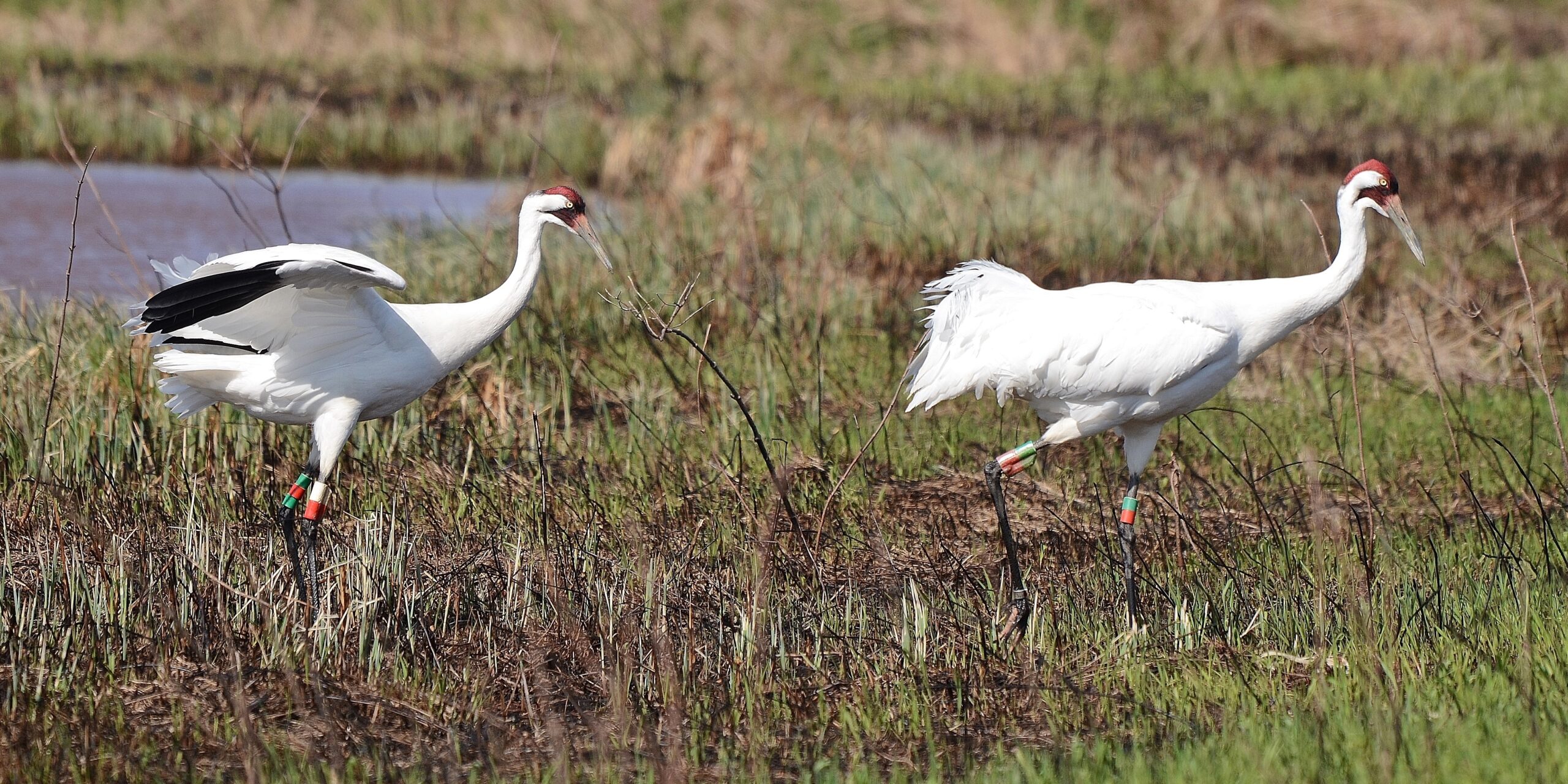
18-03 and 36-09 were seen nest building on April 9 and were sitting by the next morning. The first clutch of eggs was removed as part of the forced renesting program.
The pair renested and were seen sitting again on May 6! Chick W13-19 hatched a month later. Unfortunately, W13-19 was last seen in mid-June.
Fall 2019: 18-03 and 36-09 left their territory at Necedah National Wildlife Refuge at the end of September and arrived at their wintering grounds in Indiana by mid-October. They spent the winter at Goose Pond Fish and Wildlife Area with other Whooping Cranes before heading back to Wisconsin in March.
Spring 2020: 18-03 and 36-09 were first seen back in Wisconsin in mid-April on their territory at Necedah National Wildlife Refuge. They began nesting shortly after their arrival and hatched a chick around May 15. The chick, W11-20 is still alive as of July.
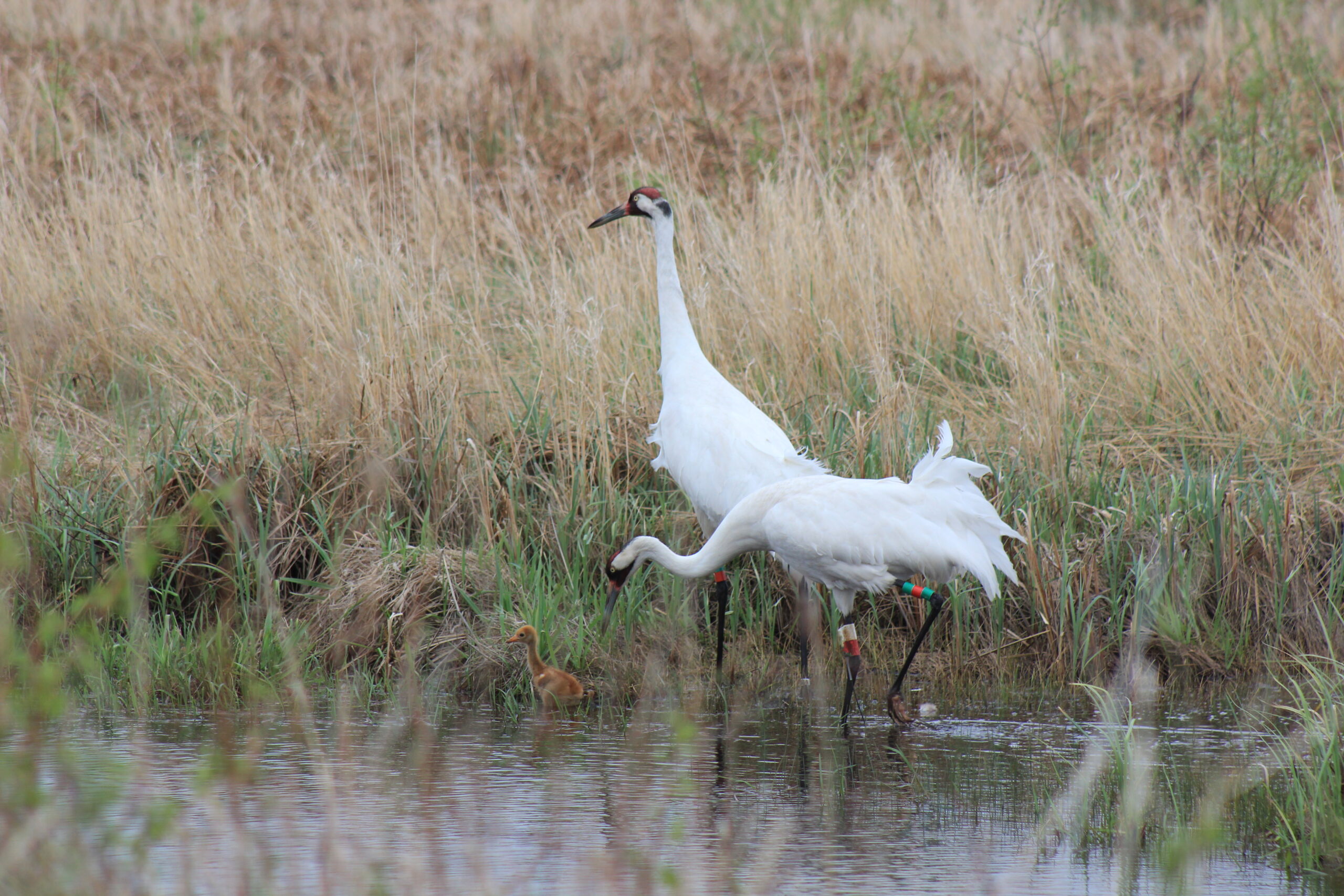
Photo: Hillary Thompson
Fall 2020: 18-03 and 36-09’s chick sadly did not survive to fledging age. They left their territory at Necedah NWR early and were first observed at Goose Pond FWA, IN in early October. They have been keeping to themselves on the wintering grounds.
Spring 2021: 18-03 and 36-09 didn’t start their migration north until mid-March but were incubating in early April at their territory in Necedah National Wildlife Refuge. Their chick is W11 once again and is still alive as of July 2021.
Fall 2021: This year 18-03 and 36-09 successfully fledged chick W11-21! The family departed Necedah NWR in mid-November, and after a brief detour to western Ohio, they ended up on their usual wintering grounds at Goose Pond FWA, Indiana. This summer 18-03 was captured and fitted with a new transmitter that allowed us to track the family’s migration down south!
Spring 2022: This spring 18-03, 36-09, and chick W11-21 migrated back to Necedah NWR in Wisconsin. Despite their successful nesting season last year, 18-03 and 36-09 split up shortly after returning to their breeding territory. 18-03 has been spending time on or near the refuge and has been seen with another single Whooping Crane, female 6-17.
Fall 2022: Unfortunately, 18-03 has not been seen since late July in Juneau County, Wisconsin. We hope he will turn up on the wintering grounds!
Spring 2023: 18-03 was not seen in Wisconsin this spring and is now considered long-term missing.
Click here to jump to the top of this page.
Crane #19-03
Sex: Male
Hatch Date: May 23, 2003
Personality Characteristics: The wimpiest bird and the one that causes trainers the most worry, but also the youngest so maybe it will come around. Trainers spending more time with this crane than any. It started out gate-shy and nervous about being away from the wet pen. Often ignores the costumed handlers unless they have treats. Not a dominant bird, but no longer gate-shy by end of August. By migration time this bird was much improved and very attentive to the aircraft.
Migration South: Flew every mile!
History
Spring 2004: Began first migration north at 9:33 a.m. March 30, 2004 in a group of eight 2003 flockmates (#1-03, #3-03, #5-03, #9-03, #12-03, #16-03, #18-03, #19-03). (Follow the group’s progress to April 9 in the entry for #1-03.)
On April 9 the group flew westward and separated south of Celina, Ohio. The group of five (#1-03, #5-03, #9-03, #18-03, and #19-03) stayed in southwest Michigan, where #19-03 was killed on July 31, 2004 by a coyote.
Click here to jump to the top of this page.

